Author: Kim Girard
“Collaboration is the key word:” Venture capital’s rise at Haas
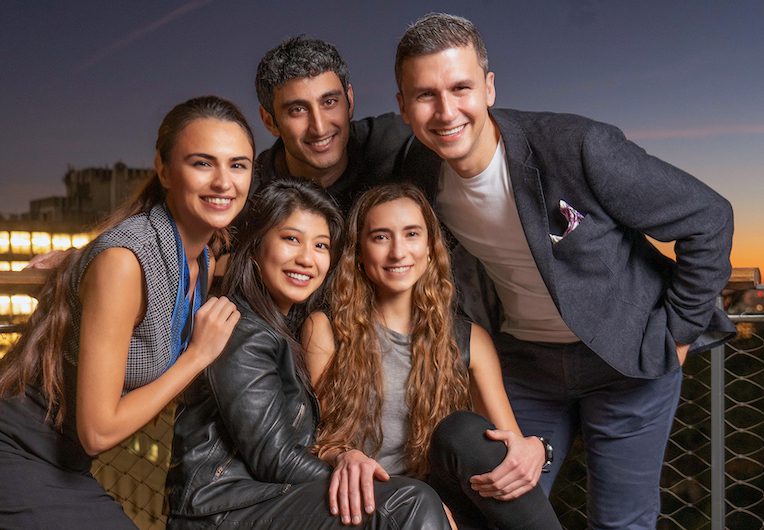
On a recent rainy night, more than 100 Berkeley Haas and Stanford GSB students convened in Chou Hall’s Spieker Forum for a first-of-its-kind Founder-Investor Mixer.
Haas MBA students Atusa Sadeghi and Alejandra (Ale) Vergara, along with Dogakan Toka, EWMBA 22 and co-president of the Berkeley Entrepreneurship Association (BEA), were behind the event. As co-presidents of the Haas Venture Capital Club, they decided it was time for students from the two programs to get to know each other in the tight-knit industry, where they’d inevitably run into each other post-graduation.
“I think collaboration is the key word here,” said Sadeghi, EWMBA 22, a former mechanical engineer who transitioned into venture capital over the last two years. “If we’re going to be in the same industry, let’s be united.”

A new fund
That shared vision for unity among investors and entrepreneurs is something Sadeghi and Vergara, full-time MBA 22, have emphasized since taking on their roles amid the Covid pandemic. Under their watch, they organized the event with Stanford, landing the support of sponsor First Republic Bank and Andrew Liou, a senior relationship manager at the bank, who “didn’t think twice before supporting the collaborative effort,” Vergara said.
Membership in the student-run VC club, founded in 2018 by evening & weekend MBA students Chris Truglia and Scott Graham, has increased from about 100 to more than 500 students, split 50-50 between the evening & weekend and full-time MBA programs. Since its founding, collaboration and networking among students from both the programs has been critical to the club’s success, Truglia said.
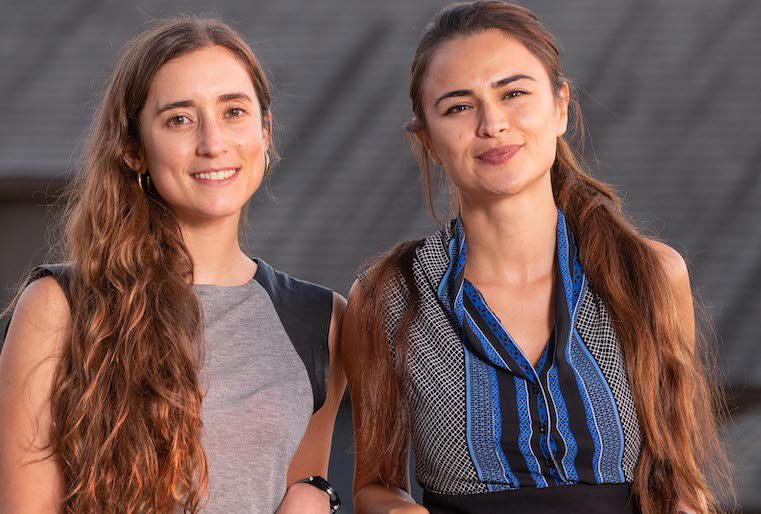
The club hosts popular pitch nights, often partnering with other UC Berkeley clubs, and has built a database with answers to the most common questions students ask about the venture capital industry. This past fall, venture capital club leadership also helped spearhead the creation of Courtyard Ventures, a new venture fund led by Haas MBA students that provides an opportunity for Cal students and alumni to invest in early-stage Cal startups. The fund has recently begun deploying capital, after exceeding funding goals and closing its first two investments in early January, Sadeghi said.
“These women are amazing—they’ve done an incredible job,” said Deepak Gupta, an investor and venture capital industry advisor with the Berkeley Haas Career Management Group.
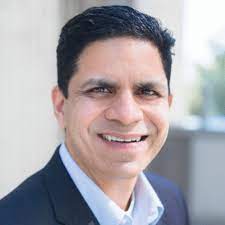
While entrepreneurship is a well-established career path at Haas, Gupta said he’s seen a shift in student interest and effort in venture capital over the past three years, as the number of Bay Area VC funds has proliferated. “Now, these funds are coming to Haas to recruit for associate and principal roles,” said Gupta, who is also managing partner of his own pre-seed fund Blue Bear Ventures started at UC Berkeley. By next year, Gupta predicts Haas could double its number of full-time offers.
That growth would be significant. For each of the past two summers, about 15 to 20 full-time MBA students interned at venture capital firms, up from just a few in 2015, said William Rindfuss, executive director of strategic programs in the Haas Finance Group. While there’s a longer track record of students studying finance going into investment banking, a total of around 10 grads took full-time jobs in venture capital over the past two years. “We’ve had more students doing VC internships, and that will likely lead to more full-time VC job offers,” Rindfuss said.
The passion for investing
But increased hiring comes down to overcoming challenges endemic to the venture capital industry. VC funds can be insular, they don’t hire on a predictable schedule, and entry-level pay can be low compared to other finance jobs—with a big payoff delayed until you make partner, Gupta said.
“Venture is so ‘just in time’ and when people hire you you start immediately. It’s not like consulting where you get your offer and start next July,” said Jeff Diamond, MBA 22, a VC Club officer and a general partner at Courtyard Ventures. But Diamond, who came to Haas to switch from a career in the entertainment industry to early-stage investing, said he’s committed to a VC career. “It’s a lot of work but it’s rewarding,” he said. “It’s what I liked about working with artists, writers, and directors. You want to be the person who works with them. The idea of being with these companies for the long haul is what interests me.”
“The idea of being with these companies for the long haul is what interests me.” — Jeff Diamond, MBA 22
There’s clearly passion for investing in the Haas alumni network, which is expanding to include graduates like Sydney Thomas, MBA 16, a principal at seed-stage fund Precursor Ventures; Matthew Divack, MBA 19, an investor at Moment Ventures, and Champ Suthipongchai, MBA 15, who co-founded Creative Ventures, a tech VC firm investing in startups that address the impact of increasing labor shortages, rising healthcare costs, and the climate crisis.
Making alumni connections
An earlier success story in venture capital, Michael Berolzheimer, MBA 07, founded Bee Partners in 2008. An internship at pre-seed fund Bee Partners piqued Vergara’s interest last year, but she worried she lacked a technical background. Then Vergara met Kira Noodleman, MBA 17, a partner at Bee, through the Berkeley Female Founder and Funder’s summit last year. “Kira encouraged me to apply,” said Vergara, who landed the internship. That led to a full-time job offer with the fund when she graduates in May.
Looking for more investment experience, Sadeghi found her internship as a senior venture associate at Blue Bear Capital (separate from Gupta’s fund, Blue Bear Ventures). She first met Carolin Funk, a Blue Bear partner invited by the 2020 Haas Venture Capital Club to speak at the school. Interviews at Blue Bear led to an offer. She then learned that recent alum André Chabaneix, MBA 21, already worked at Blue Bear as a senior associate.
“André is just amazing,” Sadeghi said. “We have a lot in common in terms of our background and industry interest so we bonded pretty quickly. In our overlapping year at Haas we participated in the 2021 Venture Capital Investment Competition (VCIC) where we ended up representing Berkeley at the global finals together—and now we’re great friends and colleagues.”
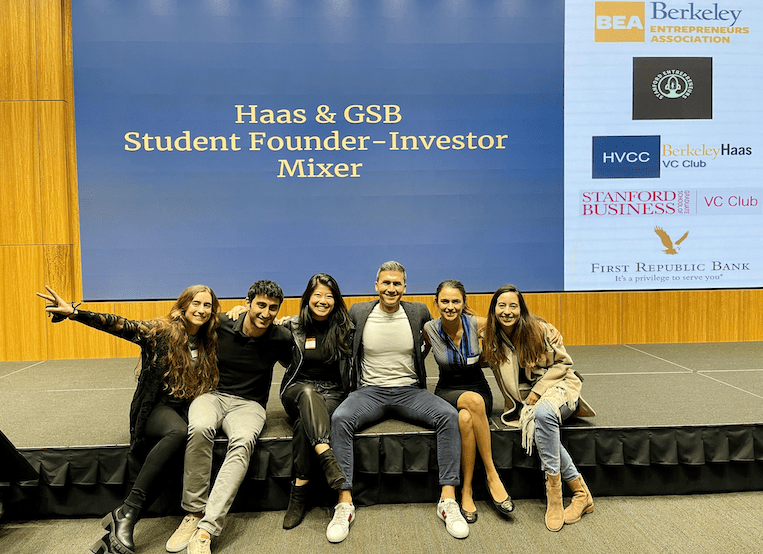
While students continue their internship and career recruitment this spring, the VC Club already has many events planned, including club-sponsored workshops, student-alumni mixer events and more collaboration with peer MBA programs. Vergara and Sadhegi encouraged students “who are just interested in learning more about VC or are fully committed to this career path,” to check out the club.
“It’s been such a pleasure running the 2021 VC club year with Ale, and we can’t wait to welcome the 2022 leadership team to carry us forward,” Sadhegi said.
How burnout built a startup
Yannell Selman, MBA 21, arrived at Berkeley Haas suffering from what she called “late-stage clinical burnout” from work.
Within months, Selman was working to solve the root causes of her own problem.
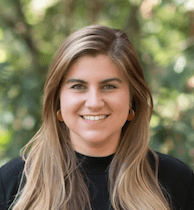
That work turned into a startup, Cultiveit, which is building an online wellness platform that human resources departments use to recommend “high-quality time-off” experiences to treat worker burnout.
“Our goal is to shift workplace culture so people have boundaries between working and not working,” said Selman, who co-founded the company with classmate Dunja Panic, MBA 21. The pair met during the UC Berkeley Student Entrepreneurship Program (StEP), which helps students find other entrepreneurs and explore the viability of their startup ideas.
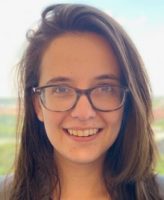
First, Selman and Panic considered a startup focused on kids, screen time, and parental burnout. Then they pivoted to exploring burnout as an adult issue. Last fall, while conducting research, they noticed a pandemic “paradigm shift” as the lack of separation between home and work increasingly impacted workers.
While working on the startup at UC Berkeley’s SkyDeck incubator, they began viewing burnout as not an individual’s problem, but as a systematic issue, connected to how work is structured.
They began viewing burnout as not an individual’s problem, but as a systematic issue, connected to how work is structured.
It starts with “a grind of nonstop work that blends from day to night,” progressing to cynicism that leads to negative attitudes toward clients and your team, Selman said. Finally, there’s helplessness. “You lose hope that anything will change,” Selman said. “You try to make a change but realize nothing works so you quit or get a new job. You take two weeks off, but then the cycle starts again.”
Selman’s leadership on the issue has attracted attention. TaskRabbit CEO Ania Smith wrote a recent Forbes article that cited the benefit of “what burnout consultant Yannell Selman calls “high-quality time off” (HQTO).”
“To qualify as HQTO, employees should engage in activities that are active and support cognitive distance (like rock climbing versus a massage), intrinsically satisfying and reconnect employees to their non-work identities (salsa dancing versus laundry), disconnected (hiking versus watching TV), sensory-stimulating (surfing versus video games) and encourage meaningful growth (woodworking versus social media),” Smith wrote.
Kelli Schultz, a senior people development specialist at TaskRabbit, recently worked with Cultiveit to help employees figure out what HQTO means to them—and urged them to make the most of a paid week off after a busy seasonal period.
After the vacation week, TaskRabbit employees shared photos, emphasizing how they’d challenged themselves. Schultz said she headed to Tennessee where she went went ziplining, left her computer at home, and hit the hot tub when she thought about checking emails.
Results of the company’s twice-annual engagement survey showed the program’s success: a jump of 12 points in employee satisfaction, which Schultz called “amazing, especially during Covid.”
Selman also worked with leaders at content management company Box last July. She held a one-hour info session about burnout, attended by 60 people; 24 people signed up to try a new HQTO experience, said Andrew Chang, corporate finance and strategy manager at Box.
Each participating employee received $50 to spend on experiences ranging from cheesemaking to a botanical garden trip. The feedback from participants was enthusiastic, and planted a seed that company leaders are responding to, Chang said. “Anyone can talk about burnout and what they think it is,” he said. “Yannell tells it to people in a way that’s meaningful. That was the “wow” moment for me.”
Selman is now planning to expand Cultiveit, working on a seed funding round and continuing work with their corporate partners. The company makes money by receiving a percentage of the cost of classes or experiences it promotes to its clients.
“The main thing is that we want to engage with the community,” she said. “We want to meet with more managers and HR leaders who see this as critical and want to participate. Nutrition and meditation aren’t enough to cure burnout. You have to change your work habits.”
Salaries, bonuses edge upward for 2021 FTMBA grads
Average salaries for the Berkeley Haas Full-time MBA Class of 2021 edged up $9,000 this year, with the consulting and technology sectors again luring more than 60% of graduates.

“I’m so pleased to see this jump in starting base salary and strong employment outcomes, which represent the continuing strength and confidence in our students and the Berkeley MBA,” said Abby Scott, assistant dean of MBA Career Management & Corporate Partnerships. “This is particularly encouraging, given the pandemic and slower reopening of the California economy. The effort that our grads put into their job searches and the help of our alumni who went beyond themselves really helped this class land jobs.”
Of the total class of 283 students, 239 students were seeking jobs. Within three months after graduation, 90% received job offers and 88% of the class—or 211 students—accepted, up slightly from 87% for the class of 2020.
A few highlights:
- Starting base salaries are up to $149,000 median from $140,000 last year.
- 72% of students received a sign-on bonus and 42.6% received stock options or grants, adding significantly to long term compensation. The average sign-on bonus was $33,775, up from $31,000 last year.
- Tech dominated employment outcomes at 34%; about 28% of the class went into consulting, up from 25% in 2020.
- About 12% of students took jobs in financial services; 10% went to startups; 6.6% landed in healthcare & biotech, 6.2% went to CPG/retail companies, and about 3% are employed in the energy industry.
This year’s top employers—companies that hired three or more graduates—included Amazon, Boston Consulting Group, Google, McKinsey & Company, Deloitte, Bain & Company, EY Parthenon, Adobe, Facebook, LEK, Microsoft, PwC Strategy and Samsung. Consulting was particularly strong this year, Scott said, with McKinsey and Deloitte hiring “the largest number of graduates we have ever seen.”
“One of a kind” Silicon Valley network
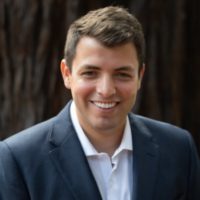
David Bolívar, MBA 21, landed a job at Google as a senior treasury analyst after interning at Uber while at Haas.
Throughout the recruiting process, he spoke with over a dozen Haas alumni who work in tech, including several Haas alumni who work in Finance at Google. “The Haas network in tech in Silicon Valley is one of a kind,” said Bolívar, who credited Haas Career Management for its help providing key points of contact and coaching him on how to deliver impactful personal stories as an international student during interviews. “The Haas MBA gives you access to a unique network of alumni and faculty who become such valuable resources for your career.”
Bolívar said he was drawn to Google’s commitment to culture and to supporting its employees professionally and personally. “Google is a consensus-driven, flat organization, which is great if you are the kind of person not looking to operate under the mandate of traditional hierarchies.”
For many students like Bolivar, connecting with Haas alumni helped ease the recruitment process. Terence Mullin, MBA 21, who works in corporate strategy and strategic finance at Epic Games, said a fortuitous connection with an alumnus helped him find his career path.
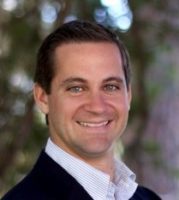
Mullin, who returned to playing video games in his spare time during the lockdown, realized how much he loved games. That led to a eureka moment: “I thought I could do this as a job,” he said.
Mullin started connecting with Haas alumni who work in gaming, and talked with Roland Luk in Haas Career Management about finding internships. The day after he talked to Luk, Chris Kavcsak, MBA 17, who works in strategy at Epic Games, reached out to Luk about an internship in strategic finance at the company, the maker of the blockbuster multiplayer game Fortnite.
Mullin, who had been working on a game pricing project independently, studying Epic’s business model, accepted an internship working for Kavcsak. “Chris took me under his wing, and three months on they let me know things were going well—and then I came on full-time.”
Choosing a startup
Other students have found internships and jobs through a collaborative online effort called Hire Haas. The program, which generated 250 jobs from alumni in 2020, doubled that number to nearly 500 job postings from alumni in 2021.
Eduardo Bustamante, MBA 21, found his MBA internship at e-scooter and e-bike startup RidePanda through Hire Haas, which connected him to Ridepanda’s co-founder and CEO Chinmay Malaviya, MBA 18.
Bustamante said he came to Haas expecting to work in consulting or tech—but his Ridepanda experience led him to interview at Canoo, an electric vehicle startup that went public in December 2020. “I got to wear different hats (at Ridepanda) and learn many things,” he said. “I liked the way it worked at a startup. That’s why I joined Canoo.”
In his role as program controller in operations and finance, he’s working on the company’s new product rollout, a lifestyle vehicle that is scheduled to launch in late 2022.
View the 2021 employment report here.
California Surgeon General Nadine Burke Harris on being a changemaker
Every semester, Berkeley Haas Lecturer Alex Budak kicks off his class on Becoming a Changemaker with examples of changemakers who inspire him. For the past two years, he’s led with childhood trauma expert Dr. Nadine Burke Harris, California’s first Surgeon General.
On Nov. 9, his students got to hear directly from Burke Harris, who answered their questions virtually as a guest during class.
“She charts her own path in everything she does,” Budak said. “From being the first-ever Surgeon General for the State of California to championing a crucial-but-overlooked aspect of childhood health, she doesn’t have a playbook to follow. She invents it herself, every day—and she does so in a way which is empathetic, humble and tenacious.”
Burke Harris, who has established early childhood, health equity, and toxic stress as her key priorities, is the author of The Deepest Well, which addresses how deeply bodies can be imprinted by or Adverse Childhood Experiences—or ACEs—like abuse and neglect. The ACEs Aware initiative is a first-in-the-nation effort to screen patients for Adverse Childhood Experiences (ACEs) to help improve and save lives.
The pandemic has worsened mental health for many, and Burke Harris pointed to the American Academy of Pediatrics, which just announced a national mental health emergency for children.
“We recognize that (the pandemic is) also this massive, massive stressor and there’s never been a more important time for us to implement trauma-informed systems and trauma-informed care at scale,” Burke Harris said. “A lot of my focus, in addition to helping with vaccines and thinking about our rollout, is our strategy for equity, which is another huge thing right now because when you have a public health emergency, it doesn’t effect everyone equally.”
Being a changemaker is about more than working hard and being intense, she said. “I work hard, that’s no joke,” she said. “But it’s really that ability to replenish ourselves, that ability to nourish ourselves and take breaks and be joyful and really integrate the work we do and our purpose, also with our lives, I think allows us to sustain the work we’re doing and it also cultivates creativity and innovation and all of things that help us be more successful and change-making.”
Asked about a changemaker she admires, Burke Harris described a Google-organized dinner she attended, where she met lawyer Bryan Stevenson, the founder and Executive Director of the Equal Justice Initiative. Stevenson worked on Supreme Court decisions to prohibit sentencing children under 18 to death or to life imprisonment without parole. “That was a total changemaker moment,” she said. “It was so joyful to talk to someone who was similarly passionate about caring for our vulnerable community members.”
This video is also listed as a Dean’s Speaker Series talk.
Junaid Lughmani, MBA 23, honored by Tillman Foundation for Afghanistan evacuation work
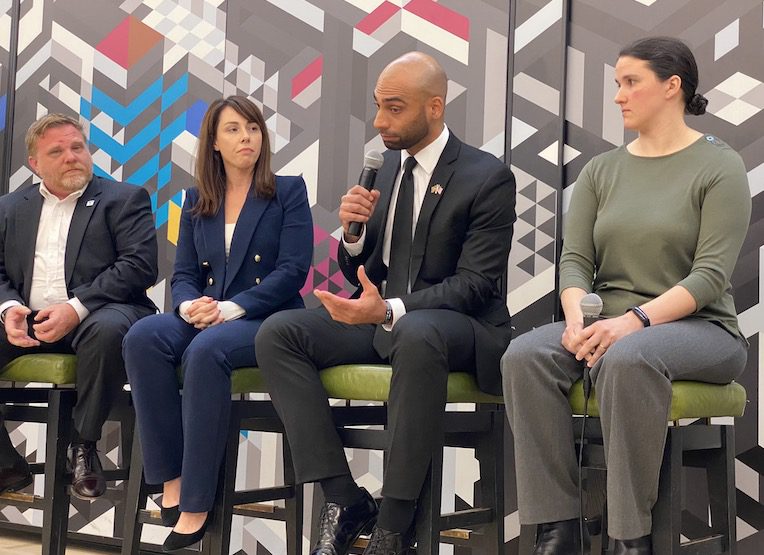
Junaid Lughmani, MBA 23, was honored by the Pat Tillman Foundation last week for his work on “Digital Dunkirk,” a massive online effort by military veterans to help evacuate at-risk Afghans following the U.S. withdrawal from Afghanistan.
The annual Tillman Honors are named for Pat Tillman, the former NFL player who tragically died in Afghanistan while serving in the U.S. Army in 2004. The event gathered hundreds of supporters, investors, Tillman Scholars, and others in Chicago on Nov. 4 to celebrate Tillman’s legacy of service and leadership. The Foundation’s 2021 Champion Award went to Afghan politician and women’s rights activist Fawzia Koofi. Previous Champion award recipients include Sen. John McCain and former U.S. Rep. Gabrielle Giffords & Sen. Mark Kelly.
Lughmani, Kate Hoit, and Rick Schumacher, who are among 60 Tillman Scholars chosen in 2021, accepted the “Make Your Mark” award on behalf of the Digital Dunkirk organizers. The Washington Post featured Lughmani’s work with former Green Beret Jon Reed in Berkeley in an Aug. 26 article. The pair joined veterans, active-duty service members, former government officials, and civil servants who volunteered to help Afghans flee Taliban retaliation.
How do we value hope?
Lughmani, a first-generation American of Pashtun origin, worked as an interpreter in Afghanistan from 2009 to 2012, serving as a liaison between the U.S. and Afghan governments. He later returned to Afghanistan with the U.S. Army as an infantry officer, leading his platoon on multiple combat missions.
In his speech during the awards ceremony, Lughmani said that while in Afghanistan he received “the greatest gifts of love, generosity, care, and goodness from the people.” “From the children who would call me “kaka” (uncle) to the elders who treated me as their own son, Afghans embraced us, broke bread with us, and truly taught us the power of human connection.”
Watch Junaid Lughmani’s speak during the annual Tillman Honors (begins at 39:57 minutes.)
Lughmani, who sought an MBA with a plan to return to Afghanistan as an investor to help grow the country’s entrepreneurial ecosystem, spoke of how torn he was in the days when he began his MBA classes as the Taliban reclaimed power in Afghanistan.
“As I sat through valuation lecturers and read through spreadsheets and assessments I wondered: how do we value hope?” he said. “Our dreams cannot be summed up by a formula in a little box. Our hearts belong in the in-between spaces. The Afghans who changed my life stepped out into the in-between spaces. If they could do that, given all they were up against, I decided that I would also choose the in-between spaces. I’d work with whoever showed up, to help as many people as we could.”
With winter fast approaching, more than half the population of Afghanistan is at risk of running short of food.
“The evacuation efforts are ongoing, and there is a desperate food crisis in Afghanistan with 23 million people at risk of facing starvation through the winter,” Lughmani said. “But refugees also need our help. There are over 50,000 refugees who are currently housed on U.S. military installations across the U.S. with little to no belongings; many possess only the clothing on their backs and about half of these refugees are children.”
Uniting B-school forces
Responding to military housing conditions, Lughmani and fellow members of the Haas Veterans Club launched a drive to collect clothing, household appliances, toys, personal care items, electronics, books, and baby supplies, for relocated Afghan refugees in Northern California.
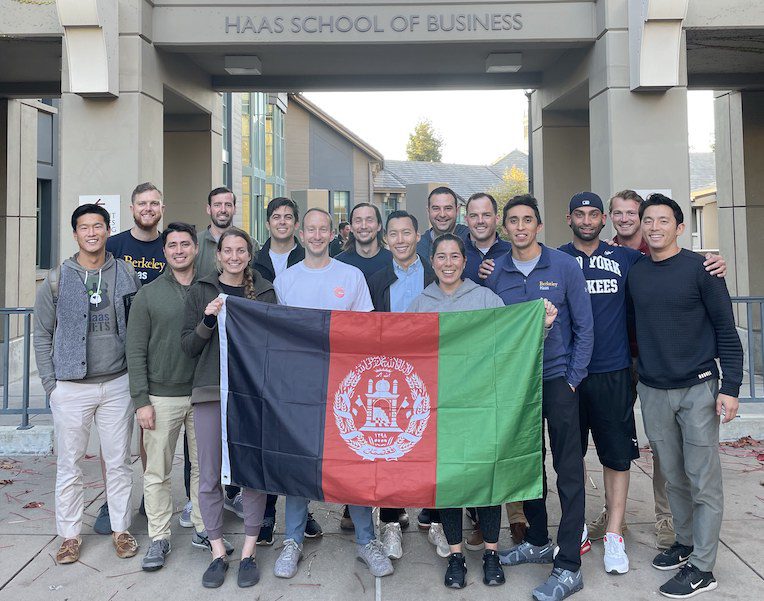
So far, they’ve collected over 3,000 items, Lughmani said. “Our donations go directly to refugees, cutting through the red tape typical of NGOs that have a more complicated aid-delivering process,” he said. “Our way enables us to identify communities that need help and respond directly through our military, veteran, and Afghan networks.”
The club is reaching out to veterans at other business schools nationwide to expand the effort. To date, veterans’ groups at Stanford’s Graduate School of Business, NYU Stern, USC’s Marshall School of Business, University of Michigan’s Ross School of Business, University of Virginia’s Darden School of Business, UCLA’s Anderson School of Business, University of Chicago’s Booth School of Business, and Northwestern’s Kellogg School of Business have signed on, and conversations continue with more schools.
The Berkeley Haas collection drive, located on the second floor of Chou Hall, is planned until Nov. 19, but may continue through the holidays, depending on need.
Black MBA Association partners with Haas on EWMBA fellowships
The Berkeley Haas Evening & Weekend MBA Program will host a kickoff event Nov. 9 for a new fellowship program aimed at increasing access to business leadership and scholarships for historically underrepresented groups.
The program, launched through a partnership between Haas and the SF/Bay Area chapter of the National Black MBA Association (NBMBAA), includes networking and mentorship, as well as the opportunity to be selected for a $50,000 scholarship. The scholarship award is more than 50% higher than most scholarship awards to students in part-time MBA programs.
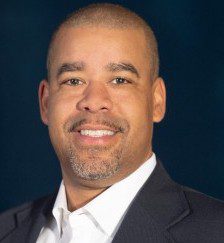
The kickoff event, to be held in Chou Hall’s Spieker Forum from 6-8 p.m., will feature guest speakers Joe Handy, president of the National Black MBA Association; Myisha Robertson, president and CEO of the San Francisco Bay Area Chapter of the National Black MBA Association; and Élida Bautista, Chief Diversity, Equity & Inclusion Officer at Haas. A panel discussion with Berkeley Haas alumni and members of the SF Black MBA Association will follow.
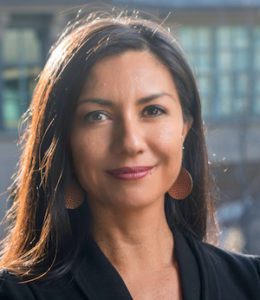
“We’re so excited to be partnering with the local chapter of the NBMBAA,” said Jenny Clare, senior associate director of admissions for the Berkeley Haas EWMBA Program. “The Berkeley Haas Equity scholarship will help us to continue to increase the diversity of the applicant pool, and, as a result, increase the diversity of student enrollment in our program.”
As an SF Black MBA Fellow, students will:
- Become a member of the SF Bay Area Chapter of the NBMBAA and be assigned a mentor who will provide counsel, connections, and guidance throughout their MBA study.
- Join a cohort and community of other fellowship recipients and their mentors in the inaugural class of SF Black MBA Fellows, which will begin in Fall 2022 and extend through their time in the Berkeley Haas EWMBA program and beyond.
- Meet regularly with other SF Black MBA Fellows and mentors, network with the SF chapter and Haas leadership, and have exclusive opportunities to connect with Bay Area business leaders.
- Be considered for one of the $50,000 Berkeley Haas Equity Scholarships, which will be awarded to SF Black MBA Fellows who exemplify commitment to increasing opportunities and access for underrepresented groups. The number of awards will depend on the applicant pool, and is estimated at two-to-four scholarships of $50,000 each, distributed over three years.
Funding for the new scholarships was provided by Jamie Breen, assistant dean of the school’s MBA Programs for Working Professionals.
“We’ve been thinking about scholarship support to increase the diversity of our working-professional student population for a while, but it’s hard to get these things started,” she said. “I have the capability to do it, so this seemed like a great place to use my philanthropy.”
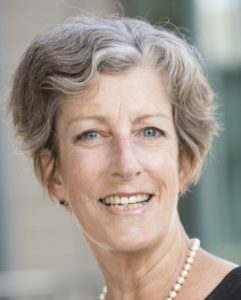
Interested new applicants should apply for the fellowship at the time they apply to Berkeley Haas, well before the final deadline of May 2, 2022, as fellowships are awarded throughout the admissions cycle, Clare said. (The scholarships are not open to current EWMBA students)
Applicants commuting to campus from outside the Bay Area, or who join the Flex EWMBA cohort, are also welcome to apply to be a SF National Black Fellow.
The fellowship application includes a 250-word essay about how an applicant demonstrated an ongoing commitment to increasing opportunity and access to people from racial/ethnic groups who are historically underrepresented in business (specifically Black/African-American, LatinX, and Native/Indigenous communities).
Berkeley Haas has long been an NBMBAA educational partner, and sought to further this relationship with the local chapter, where some Haas alumni are already active.
The San Francisco Bay Area chapter of the National Black MBA Association is open to Haas MBA students as graduate-level members. Visit their website or contact [email protected] to learn more.
Berkeley Haas real estate curriculum gets a climate change makeover

The first thing real estate professor Nancy Wallace asked her students to think about last semester was rain.
“Pick a city like Miami,” said Wallace, chair of the Real Estate Group at Haas. “When it rains in Miami, the sewage treatment plants flood, the water mains back up, and the streets are flooded. The same with Houston. We’re not talking about a hurricane, which would be 10 times worse—just a regular very rainy day. Because the infrastructure in these cities is below sea level, the risk is just huge.”
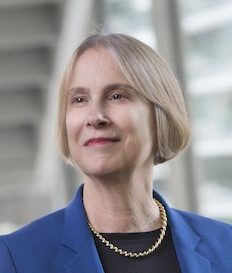
And with that intro, students in Wallace’s Real Estate Investment and Sustainability class began to consider the risks for cities that are fundamentally unequipped and slow to adapt to the impacts of climate change.
From flooding to wildfires to rising temperatures and other extreme weather events, climate impacts have rapidly moved from the theoretical future to the most pressing challenges facing the real estate industry today. Wallace, co-chair of the Fisher Center for Real Estate and Urban Economics at Berkeley Haas, has responded by reshaping the real estate curriculum to focus on sustainability.
“The classes, our research, and everything that we now do will be taught through a lens of sustainability,” said Wallace, the Lisle and Roslyn Payne Chair in Real Estate and Capital Markets. “We’re addressing how climate change impacts all parts of the industry—from development and building to mortgages and mortgage-related securities to the insurance markets.”
Course changes
The Fisher Center’s real estate program provides both academic and interdisciplinary training in real estate investment, real estate law, and the role of real estate development in the built environment. MBA students, along with students in the College of Environmental Design and Berkeley Law, can earn the Center’s Interdisciplinary Graduate Certificate in Real Estate (IGCRE).
Recent curriculum changes impacted two core real estate courses: Real Estate Investment and Sustainability, and Real Estate Finance and Securitization.
Project work in both classes centers on developments in cities, which occupy 2% of the world’s land mass but consume two-thirds of the world’s energy and account for 70% of carbon dioxide emissions, according to C40, a network of the world’s megacities addressing climate change. What’s more, most of the world’s urban areas are on coastlines that are at risk from rising sea levels and coastal storms.
Project work in both classes centers on developments in cities, which occupy 2% of the world’s land mass but consume two-thirds of the world’s energy.
“It’s so important that Haas is making this shift to help students approach these problems and move to solve them from the sustainability side,” said Michele de Nevers, executive director of Sustainability Programs at Haas.
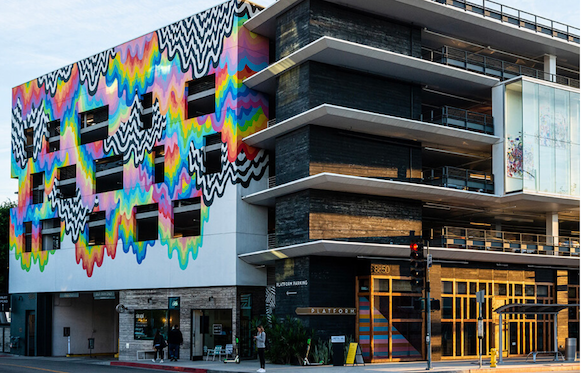
The Real Estate Investment and Sustainability class, which Wallace co-taught with architect Edward McFarlan, examines the challenges and opportunities in creating the next-generation city, including rethinking density, transit, mobility, infrastructure, and equity.
Last spring, students worked on final team projects centered on sustainable redevelopment of two Bay Area sites: the Stonestown Mall in San Francisco, owned by Brookfield Properties; and the Bayfair Mall in San Leandro, owned by Madison Marquette.
Students assumed that both sites could be redeveloped with a “blank slate” approach, and their charge was to convert both sites to a mixed-use development with affordable housing and live-work-shop components.
The Bayfair Project, outlined in a class project book Wallace compiled called “Building the Sustainable City,” included ground floor retail, a solar canopy over the garage, a shared electric vehicle program, and EV charging. Students also recommended installing puzzle lifts, a semi-automatic parking system that moves cars both vertically and horizontally to create more parking space.
Looking back, Kyle Raines, MBA 21, said the project made him understand how ESG and sustainability extend to the community around a project and can help a project thrive in the long term. “Not only will it get good press, but it will help develop land around the project and create momentum,” he said.
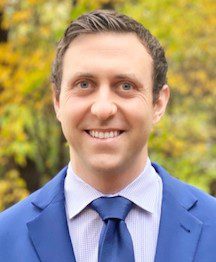
What Raines learned in the class also helped him pitch investors when he was starting Crown Point, a real estate private equity fund. “The thing I think that most struck me from the class is how much investors care about ESG and sustainability—how creating that sense of community at that property is not only a competitive advantage, but also the right thing to do,” he said.
Angus Maguire, MBA 21, said the Bayfair Project helped him better understand the real estate industry and apply what he’d learned in class from the many industry speakers.
“I took the course because I knew I would be working with real estate developers or real estate asset owners sometime in the future in my renewable energy career, so wanted to better understand how they think about project economics,” he said.
Real-world research
In the Real Estate Finance and Securitization course, Wallace, who is teaching the class this semester, draws from real-world research and the students explore real estate market data in depth.
Sabin Ray, MBA 22, said one highlight was learning about Berkeley Law’s recent findings on the City of Berkeley’s well-intentioned Property Assessed Clean Energy Program. The program allowed property owners to borrow money for renewable energy systems or energy efficiency improvements, and make payments through a special assessment to their property tax bills. But the research found that the program raised the property taxes of low-income residents, while underdelivering the promised green benefits.
For their final projects, students in the class will be able to access the electronic S&P Global database through a subscription that the Fisher Center subsidized. The database includes balance sheet, performance, and corporate Environmental, Social, and Corporate Governance (ESG) strategies. Students tap the data to analyze current ESG strategies in the Real Estate Investment Trust (REIT) industry.
“The purpose of the Fisher Center subsidy is to provide MBA students with very granular firm-level data that connects the dots between performance and sustainability strategies within real estate operating companies,” Wallace said.
Ray said the sustainability focus of the course appealed to her and that the project finance work will help her as she pursues an impact investing career. “A lot of things we are learning in class I can apply to other areas of financing,” she said.
Classified: Using data and art to inspire conversations about climate change
“Classified” is a series spotlighting some of the more powerful lessons faculty are teaching in Haas classrooms.
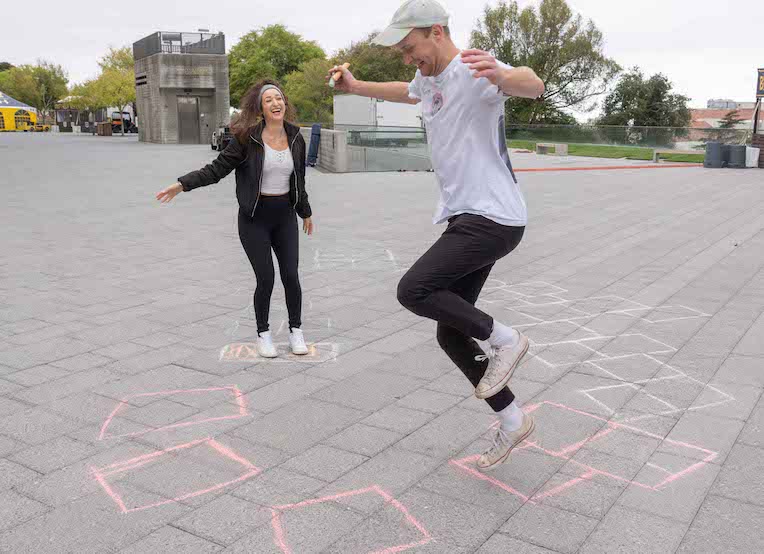
High above campus in Memorial Stadium last Wednesday, George Milanović, MBA 22, is lying on the pavement drawing hopscotch squares. It’s the first sign that this is not the usual business school class.
His project partner, Laila Samimi, MBA 22, stands nearby. She translates what Milanović is doing.
“The shorter path is the point of no return if the earth’s temperature rises two degrees Celsius—the path of corporate greed and individualistic behavior,” Samimi says. “The other is a path of sustainability. It’s a longer path and it’s harder.”
Heavy stuff for a child’s game, but the hopscotch project makes perfect sense as art created in a new course called Sustainability, Art & Business.
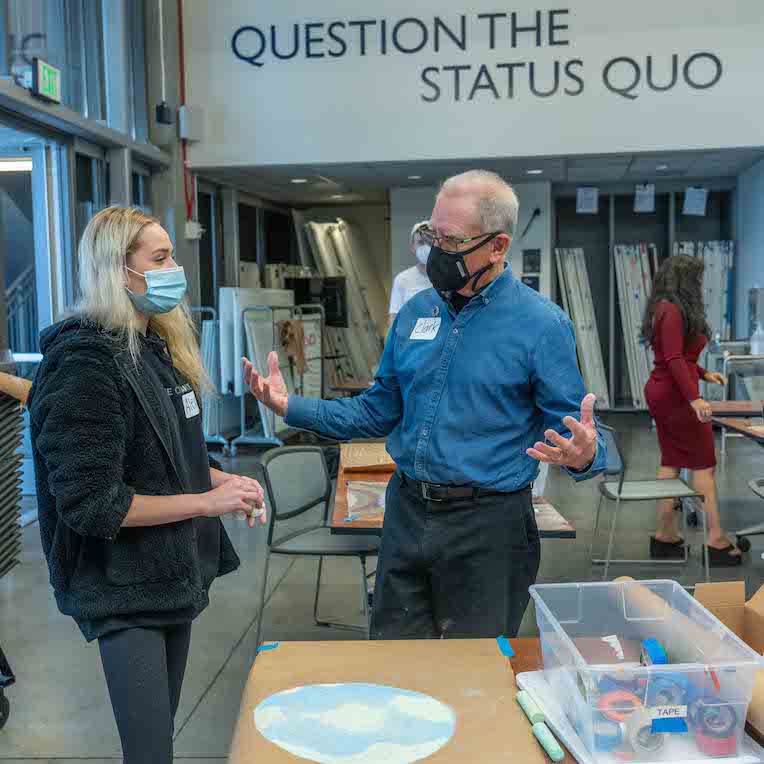
The course calls on 25 undergraduate and MBA students to explore the meaning of sustainability—and the human response to global warming—through art.
“My hope is that this art will help people to see things differently–to reframe problems and challenge our comfortable assumptions,” says Clark Kellogg, a continuing lecturer with the Haas Professional Faculty and the Haas artist-in-residence. “We’re using art to invite people into a new relationship with sustainability, to inspire a different conversation that’s not about guilt or shame.”
“We’re using art to invite people into a new relationship with sustainability, to inspire a different conversation that’s not about guilt or shame.” — Clark Kellogg
The course, taught in the Berkeley Haas Innovation Lab, builds upon a series of classes Kellogg has taught at Haas over the past decade—from Creativity Lab to Art from Business to the pioneering Design Thinking class.
Kellogg’s classroom method combines experiential learning-by-doing coupled with deep collaboration and peer-to-peer-critique, all on display in the new course. This morning, the class is focused on design, which is the second step of the three-step process for making public art that includes research, design, and execution.
Kellogg grabs a large roll of paper and starts cutting.
“Let’s just start to play,” he says, as the class splits into small groups, clutching chalk, recyclable materials, and other supplies.
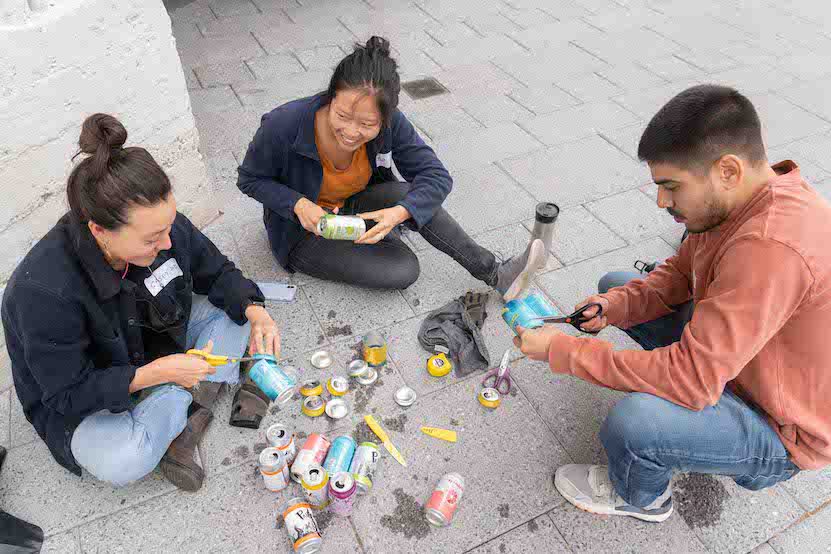
Preparing for the pop up
The idea is to finish something today that can be transferred to the Haas Courtyard next Wednesday to share during a pop up show.
Casey Dunajick-DeKnight and her team sit outside cutting recycled seltzer cans into shiny, flat metal pieces that will be used to craft sea creatures that are disappearing from oceans. Dunajick-DeKnight says she’s inspired by origami and found that aluminum is a flexible material “that cuts like paper.” Kellogg says he’s pleased that the cans are finding a second life as aluminum squid and crabs. “If it’s single use, and we use it twice, we cut the problem in half.”
Meanwhile, Zarine Kakalia, BS 22, is using chalk to draw a river that’s been diverted so many times that there’s no water left for the salmon. “I thought this was an interesting way to address resource constraints,” says Kakalia.
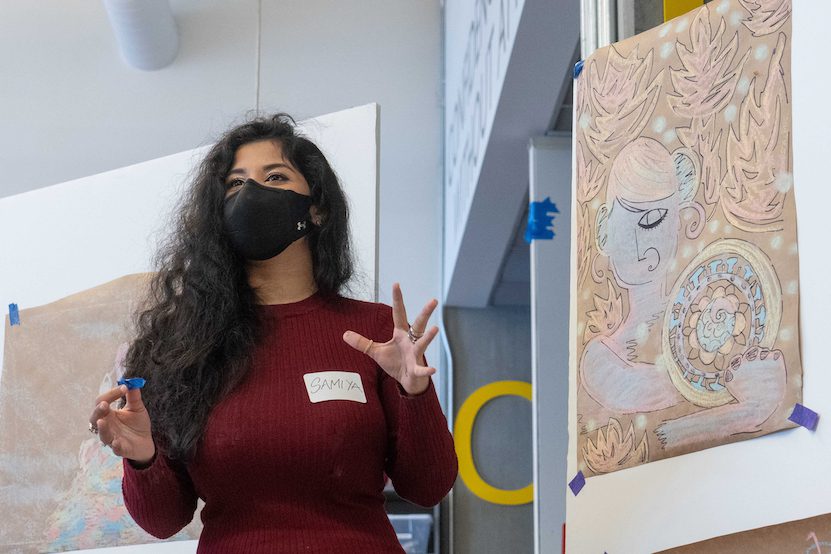
The class spends an hour working on projects before gathering for storytelling, where one group member describes the project to the class. Rachel Stinebaugh, MBA 22, shares an idea for a game of courtyard twister, with the dots representing vanishing coral reefs. Samiya Mehreen, BS 23, explains a drawing that explores the role of women artisans in developing countries, who are balancing sustainability and business. And Vincent Chang, MBA 22, says his drawing should provoke people to think about the future of a sky obscured by greenhouse gases. “It’s rainbow versus anti-rainbow,” he says.
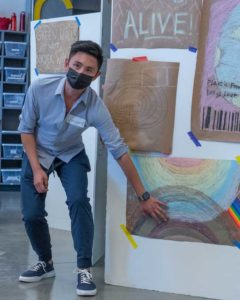
Kellogg offers praise and gentle prompts for students to take their ideas to the next level.
Before class breaks up, the students head outside to check out the hopscotch game. One student asks Kellogg if he remembers how to play hopscotch. Kellogg pauses, but then obliges, skipping through the squares as the group cheers him on.
Making a plan
Afterwards, the students must decide whether to transfer their projects in some form to the Haas courtyard or recreate their projects on site. The group votes to create their art on site. “Drawing time will be critical,” Kellogg warns, and the group agrees to plan more during the week on Slack, and meet at the courtyard by 10 a.m. on Wednesday.
“It will be so great to look at the chalk drawings on the ground and think: ‘We did this,’ ” Rosa Huang, MBA 22, says.

After next Wednesday’s event, a second courtyard pop-up show is planned for December, followed by a final gallery reception of student art.
Throughout the course, the class will read books like “Think Like an Artist” and “In Pursuit of Inspiration” and news articles that detail the links between taking walks and creativity and the importance of taking time to be alone to just think. (One of Kellogg’s personal projects was to document his commitment to making art daily.)
Among the students, many of whom are involved in sustainability-focused student groups and working at environmentally-related internships, the consensus is that the class is fresh and fun, tapping a different part of their brains.
“As business school students we are often comfortable with data and frameworks and this class helps us break away from that and be creative and think of things on the spot,” says Alejandra Arrué, MBA 22. “That’s why we enjoy the class.”
Haas expands annual Diversity Symposium to alumni and community
The Berkeley Haas Diversity Symposium this month will bring together prospective students, and—for the first time—alumni and the Haas community for a weekend of events featuring top industry speakers and showcasing the school’s commitment to diversity, equity, inclusion, and belonging.
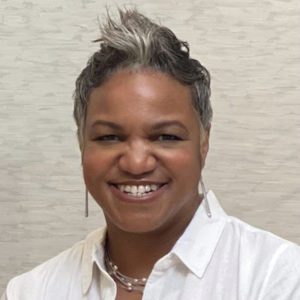
The annual symposium will be held virtually this year over three half-days from Friday, Oct. 22 to Sunday Oct. 24. Organizers, including Berkeley Haas Alumni Relations and the Office of Diversity, Equity & Inclusion, in partnership with MBA Admissions, expect about 600 prospective students and 200 alumni to join. While the symposium has traditionally been an event for prospective students, a special morning of programming on Friday is also geared toward alumni and the the Haas community for the first time.
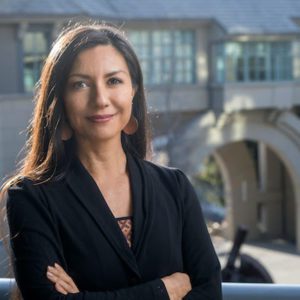
“We’ve expanded the symposium to make it a signature event for Haas that showcases the school’s DEI strategy and highlights areas where Haas is leading the way,” said Liz Rosenberg, director of Alumni Engagement & Leadership Development at Haas.
The program on Friday, Oct. 21 includes:
- A talk on the state of DEI at Berkeley Haas with Interim Chief Diversity, Equity & Inclusion Officer Élida Bautista.
- A keynote conversation with Rosanna Durruthy, vice president of Global Diversity, Inclusion, and Belonging at LinkedIn. “For over 35 years, Rosanna Durruthy has advocated for a more inclusive corporate America as an openly queer leader,” Business Insider wrote of Durruthy. “Now, as LinkedIn’s head of diversity, she’s clearing the path for other LGBTQ professionals.”
- A discussion addressing “Business as a Catalyst for Social Change,” featuring alumni thought leaders including Rachel Williams, BA 97, head of equity, inclusion & diversity at X, the moonshot factory; Marcus Chung, MBA 04 and vice president of manufacturing & supply chain at ThirdLove; Elisse Douglass, MBA 16, co-founder of the Oakland Black Business Fund;
and Robert Chatwani, EWMBA 07, CMO of Atlassian. (Hector Preciado, MBA 11, will moderate)
On Saturday, Oct. 22, Dean Ann Harrison will welcome prospective students. Other highlights include tips from admissions officers, an interactive discussion on “crafting your authentic story” with Doy Charnsupharindr, a member of the Continuing Professional Faculty at Haas, and information on financing an MBA.
On Sunday, sessions include a networking event for prospective students, a mock class with Kimberly MacPherson, executive director of the Graduate Program in Health Management at Haas, and an overview followed by a Q&A with the Haas Career Management Group (CMG).
Register for the Diversity Symposium here.
Why Berkeley Haas leads in Bay Area investment banking
Rita Wiley, MBA 22, spent last summer interning at Piper Sandler’s San Francisco offices, taking in sweeping waterfront views from the 31st floor as she worked on healthcare investment deals with her team.
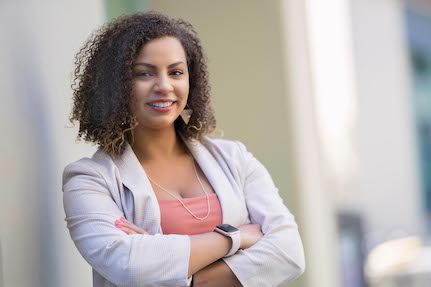
“On the first day, my managing director threw me into a live deal,” said Wiley, who spent a decade in project management with the U.S. Army before coming to Haas, where she was drawn to the work ethic and quick skill-building that investment banking demands. “I was given responsibility to run with projects.”
With that internship, Wiley joined a group of 14 Haas MBA students who worked as 2021 Summer Associate interns at Bay Area offices of investment banks. Now the top go-to business school for such hires, Haas typically nabs the largest—or over a 20%—share of the some-65 available IB Summer Associate slots each year. Internships, which are largely in either technology or healthcare investment banking, are critical because they lead to full-time positions at graduation with a very high return-offer rate relative to other industries.
“Haas produces world-class talent right here locally for the sought-after Bay Area offices, which focus largely on high-growth tech clients, and we perennially have the largest share of associates here at the global intersection of tech and finance,” said William Rindfuss, a member of the continuing professional faculty in finance who also manages financial services recruiting at Haas.
“Haas produces world-class talent right here locally for the sought-after Bay Area offices,” —William Rindfuss, who manages financial services recruiting at Haas.
Impressive alumni

Haas’ influence in investment banking grew for many reasons, including a strong finance faculty and curriculum, a Career Management Group (CMG) that’s well-connected to the top banks and supports students through the often intense recruiting process, and a powerful alumni network, Rindfuss said.
Importantly, those alumni show up for popular events like firm networking nights and the Investment Banking Speaker Series course, which recently featured Kate Claassen, MBA 07, head of West Coast Technology Investment Banking at Morgan Stanley, and will feature Nils Hellmer, MBA 15, an Executive Director at Goldman Sachs.
“Our alumni are so supportive and inspiring to the students,” said Rindfuss, a former J.P. Morgan banker, who has been at Haas since 2008. “You’ll find Haasies at all the top investment banks and we’re so grateful that they take the time to give back to the school and our students—while at the same time seeking new talent.”
Berkeley Haas’ investment banking network has grown over the decades, said Steve Etter, who teaches finance at Haas and is a founding partner at Greyrock Capital Group. Cal alumni helped build big investment banks of the 1970s and 1980s—banks like Montgomery Securities, Hambrecht & Quist, and Robertson Stephens, where alumni flocked. “Cal alumni helped build this West Coast community,” Etter said. “Then the Morgans and Goldmans started to build bigger West Coast presences. We now have senior (Cal) people across all the banks.”
Recruiting help from campus

Berkeley Haas MBA students coveting jobs in investment banking compete with students from top programs including Wharton, Booth, and Columbia. The jobs are in demand because investment banking pays very well, with a standard $175,000 salary, a typical $50,000+ signing bonus, and year-end performance-based bonuses—all very strong compared to the average MBA graduate compensation, said Abby Scott, assistant dean of MBA Career Management and Corporate Partnerships.
“But the jobs not only pay well, they offer recent MBA hires some pretty amazing opportunities,” Scott said. “New MBA associates often become part of live deal teams working with high-profile clients in tech, healthcare, and other high-growth sectors.”
“But the jobs not only pay well, they offer recent MBA hires some pretty amazing opportunities,” —Asst. Dean Abby Scott.
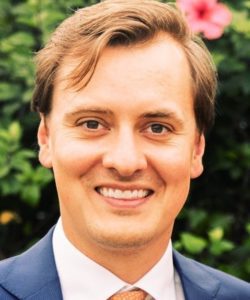
MBAs typically commit to investment banking quickly as they have to start preparing for internship recruiting early. “For investment banking you have to know early on if you want to do it because an IB internship is pretty much a requirement for a full time offer,” said Wiley, who was among 13 finance students chosen as 2020 Finance Fellows, receiving partial scholarships, priority registration for finance courses, and mentorship.
Andrew Elliott, MBA 22, said he was “95% committed” to investment banking when he arrived at Haas after working in strategy and business development at Boeing. Elliott worked for six months with Abby Franklin, an investment banking industry specialist with the Haas Career Management Group (CMG), to better understand both the career progression and work-hour demands.
He applied to multiple firms, a few on his own and most through CMG. CMG’s on-campus recruiting resources—that covered everything from resume design to networking events and interviews—helped Elliott land a summer internship at Citi, where he had already connected with his peer advisor, Ryan Alders, MBA 20, an associate in technology investment banking at Citi. “When I first saw CMG’s requirements I was a little scared because they seemed so specific, but in the end, the process protected me because I ended up with a solid job offer,” said Elliott, who will start a full-time job at Citi this spring, after graduating early.
Christine Jan, who also worked closely with CMG, said she spent hours talking to Haas alumni at different investment banks about everything from deals to the nuts and bolts of jobs to personal life management advice before landing an offer.
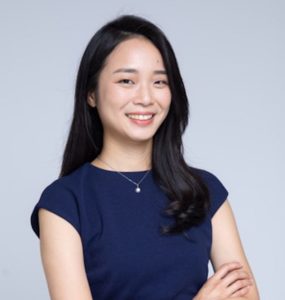
With Franklin’s guidance, Jan reached out to Shilpi Saran, MBA 13, a vice president in technology investment banking at Morgan Stanley. “Shilpi got me interested,” said Jan, who grew up in Taiwan and worked in wealth management at UBS in Hong Kong before coming to Haas. “It’s a process. We have alumni who are performing exceptionally well and they draw us in.”
During recruitment, Jan also met UC Berkeley alumnus Michael Grimes, head of Global Technology Investment Banking for Morgan Stanley, who also founded Berkeley’s M.E.T. program, an undergraduate dual-degree program in business and engineering, and Michael Bausback, MBA 19, an associate in global tech investment banking. Jan committed to a summer internship in tech investment banking with them that led to a full-time job offer. (Jan will join Adhithya Ravi and Alex Wong, both MBA 22, who are also heading to Morgan Stanley Bay Area investment banking offices).
“I loved (the internship),” she said. “It was a deep dive into investment banking. I got to realize what it was and connect the dots to what I’ve done before, connecting my work in Asia and here. It was a great, overwhelming, inspiring experience.”
The boutique path
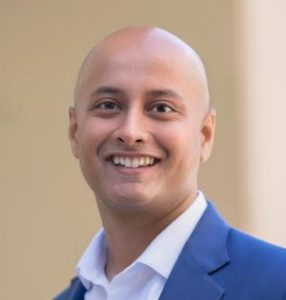
While bigger firms like Morgan Stanley, J.P. Morgan, and Goldman Sachs draw Haas students each year, a smaller firm like Moelis or Evercore can be a better fit for other students—many who say culture, regardless of size, influences where they end up.
Rawool Sahu, MBA 22, who shifted from a career in corporate financial planning and analysis to investment banking through Haas, will join Moelis, a boutique investment bank, in its thriving San Francisco office next July. (Moelis’ founder and CEO Ken Moelis just announced that the firm had raised pay for first-year analysts because “business is booming” and deal flow is rising.)
Sahu said there are benefits to joining a smaller firm. “Moelis has a smaller office on the West Coast and you get more time with the senior bankers here. At banks on the East Coast, that’s harder.” In a smaller office, he said, work also feels more focused. “Managing directors communicate more directly about what they want, so we don’t waste time. It makes things more efficient.”
At Moelis, Sahu joins a group of Haas alumni, including Adam Burgess, an investment banking associate from the class of 2020, “who helped me to make inroads in the West Coast office,” Sahu said.
“You can do this”
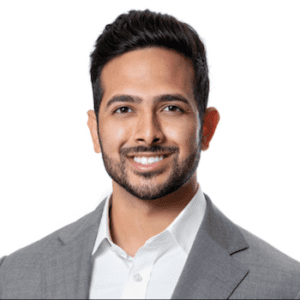
With the 2023 MBA class now on campus, finance students are attending the Investment Banking Speaker Series—along with three networking events each week that connect them with bankers—and preparing for investment banking internship recruiting.
Ravi, who is co-president of the Haas Finance Club, said recruiting with investment banks was one of the most difficult experiences that he has gone through in his life, which is why he’s helping first-year students as one of three peer advisors.
This year, he said the Finance Club rolled out a new guide to everything a recruit will need to succeed, including a networking primer, study schedules, interview prep, and advice for finding a bank that’s a good internship fit. “I’m constantly reminding recruits to leverage those around them and support one another,” Ravi said. “Having a support group and people to prep with helped so much,” he said.
To prospective Haas investment banking students, Wiley offered encouragement. “I had an interest in finance on the personal side but never thought I would make a career out of it,” said Wiley, who accepted a job with Piper Sandler after graduation. “I’m a prime example that you can do this.”
Community celebrates new MBA lounge, the Shneyder & Kirk MBA Commons
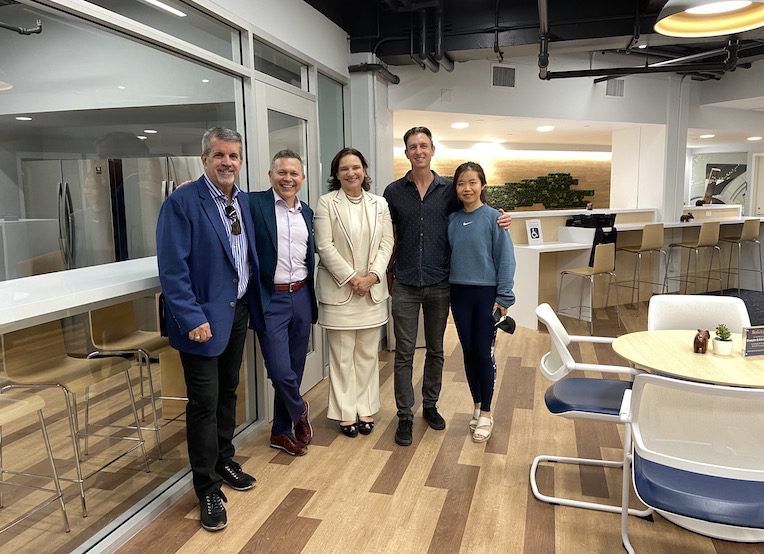
The Berkeley Haas community gathered yesterday to celebrate the grand opening of the Shneyder & Kirk MBA Commons, a larger, brighter space for MBA students to study and collaborate.
The MBA Commons is named for Mikhail Shneyder, EWMBA 08, and his husband, Jim Kirk, in recognition of their generous $1 million gift to the school.
The 2,300 square feet of space, which previously housed the FIFO Café, has been in the works since 2019. The opening of Chou Hall and Café Think provided an opportunity to reconsider the use of the space, Dean Ann Harrison said at the grand opening.
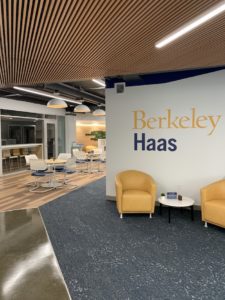
Haas student leaders, who worked on focus groups to develop the plans, asked for a lounge that was bigger, updated, and more inviting.
“We heard you,” Harrison said. The new space offers multiple seating areas, varied furniture options, a kitchenette, private phone booths, contemporary fixtures, portable charging stations, and even a digital trophy wall where MBA student achievements and awards will be showcased.
Previously, MBA students met outside of class in a room off the upper Bank of America Forum, which seats about 20 people. The Shneyder & Kirk MBA Commons is three times the size of that space.
“Thrilled to give back”
Harrison said Shneyder, who immigrated to the United States from Belarus at 19 after earning a nursing degree, speaking no English, is “the archetype of our Defining Leadership Principles.”
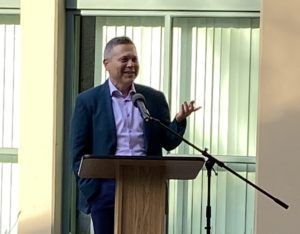
After pursuing business classes as an undergraduate and, later, an MBA at Haas, he became CEO and president of Nightingale College, a nursing school headquartered in Salt Lake City, Utah.
Shneyder said Nightingale’s success was born “in Haas classes and in our group work.”
“We generated all these ideas that we are implementing day and day out,” he said. “My hope is that that you will generate so many new ideas that will continue to question the status quo and build the future that is equitable and accessible and good for everybody.”
Harrison lauded Shneyder’s goal to change the world “by improving health and revolutionizing access to quality education for health care professionals from varied socioeconomic and geographic backgrounds”—and for giving back to Haas.
“Mikhail, Jim, we are beyond thrilled to be the beneficiary of your success and generosity,” Harrison said. “We thank you for holding a special place in your heart for this Haas community.”
Startup Ashita brings NYC flair to jewelry line

When Ashita Dhadda was in eighth grade, she designed her first piece of jewelry, a decorative arm cuff. Her parents, who owned a jewelry business, helped her manufacture the cuff in India, and she quickly sold most of them to her Fort Lee, New Jersey, neighbors.
“I wanted to get started on something, mainly for young girls to wear to festivals or dinners,” said Dhadda, BS 23. “I sold 80 of them in the building just for fun and gave the profit to charity.”
Dhadda’s early success planted an entrepreneurial seed. Last year, the Haas junior launched online fine jewelry startup Ashita, an e-commerce business that offers unique, high-quality, 14 karat gold jewelry that she designs.
Pops of color
Pops of color are Ashita’s staple—gold necklaces flecked with turquoise and orange stones; drop earrings with baby pink stones, and aqua enamel bands studded with a tiny diamond. Dhadda manufactures all of her jewelry in New York City, where she works on Fifth Avenue in the summer. She names her pieces of jewelry after New York locations like Brooklyn and the Hamptons.
“A lot of the inspiration comes from what’s around me,” said Dhadda, a double major in business and data science. “Everything around us is super colorful in New York—with SoHo and all of the shopping.”

Last summer, Dhadda decided to expand, and assembled a group of 14 interns from East and West Coast colleges to help her with business development and marketing Her crew includes Paloma Aguilar, BS 21 (Media Studies, Political Economy), who models the jewelry and serves as an Ashita Instagram influencer. With the interns’ help, Ashita has hit some milestones, including passing the 300 customer order mark and reaching $50,000 in revenue.
More good news arrived when Ashita was approved to sell one of its trademark Manhattan rings on Amazon’s website. Dhadda just ordered 500 bands to fulfill orders.
Launching a new line
Juggling a growing business with her heavy course load is tricky, Dhadda said. She logs many work hours between study sessions, answering customer emails, doing outreach with influencers and brand ambassadors, and crunching the data required to figure out what’s selling on her site and how her customers are finding her.

This fall, her interns, who assist with everything from Midtown photo shoots to visits to small Soho boutiques, will help Dhadda plan the launch of the spring line. The line includes 40 new pieces of jewelry she designed.
Analyzing sales data is helping Dhadda to figure out her company’s niche. “I’ve realized that most of what we sell is in the $200 to $300 price point so we are focusing on that,” she said.
This semester, she said she’s planning to join a Data Science Club at Haas. She’s also a member of Berkeley Women in Business, which connected her to her mentor Tanvi Lal, MBA 20.
Lal introduced her to other MBA students who have advised her on everything from accounting to marketing her startup.
“I talked to her every week last semester and that was very helpful,” Dhadda said. “She’s had a huge influence on shaping my business.”
Dhadda added that she tries to take on projects in her courses that will help her improve different aspects of her business. She also continues to network.
“Now that I’m taking Haas classes I am looking to grow and network with students and alumni,” she said. “Learning from other people’s stories and experiences has had a huge impact.”
Together again! Undergraduate Class of 2020 celebrates belated commencement

On Sunday, some 4,250 undergraduates, including about 230 from Berkeley Haas, returned to Berkeley for a promised Class of 2020 In-Person Commencement at the Greek Theatre.
For many, the outdoor event — held at 9 a.m., 2 p.m. and 7 p.m., depending on one’s major—served as both a joyful celebration and a reunion after the COVID-19 pandemic forced students to finish senior year with quick, if any, goodbyes, as they finished their classes remotely.
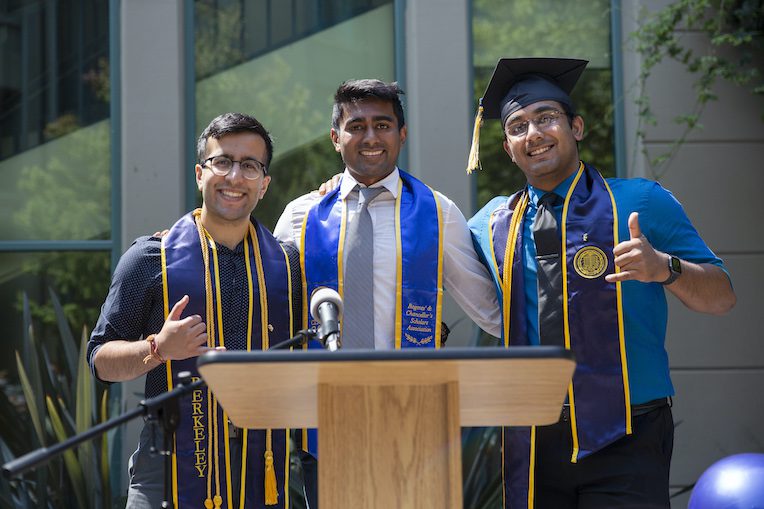
“The small act of walking across the stage, going to a ceremony, getting the Haas gift bag, meant so much to me,” said Ishan Sharma, BS 20, who worked at McKinsey & Company after graduation and just started a new job at healthcare company Athelas. “It probably took 15 seconds (to cross the stage), but it brought closure to over four years of my time at the university.”
Sharma and the Haas 2020 undergraduate class were invited to walk the stage with the 9 a.m. group. About 231 members of the 376-member class of 2020 signed up to walk.
Robert Paylor’s journey
Dry eyes were hard to find when former Cal rugby player and 2020 Haas grad Robert Paylor’s name was called. (Watch Cal Athletics video below by Laura Furney)
Told he’d never walk again after suffering a catastrophic injury while playing rugby as a sophomore, Paylor crossed 10 yards of the stage on foot, using only a walker, and received a standing ovation.
“I’m so beyond excited to be able not just to receive my degree, but to be able to physically do this,” said Paylor, who lives in El Dorado Hills and is writing a book about his journey. “This is one of the happiest days of my life.”
Tom Billups, associate head coach of the UC Berkeley rugby team and Paylor’s trainer when he was on campus at Haas, walked behind him as six family members cheered him on. His long-time girlfriend Karsen Welle, walked behind Paylor, receiving her degree in social welfare. She held back tears as Paylor rose from his wheelchair and fellow grads clapped and shot photos and video.
As he left the stage, the crowd roared and Paylor, waved, grinned, and offered a “Go Bears.”
Paylor’s mother, Debbie Paylor, said she was both nervous and excited for her son, who has lived and trained at home with her since the pandemic began. “He’s an inspiration,” she said in an interview before commencement. “His ability to overcome this, it’s an inspiration to me. I don’t think there was a time when I thought he’d give up.”
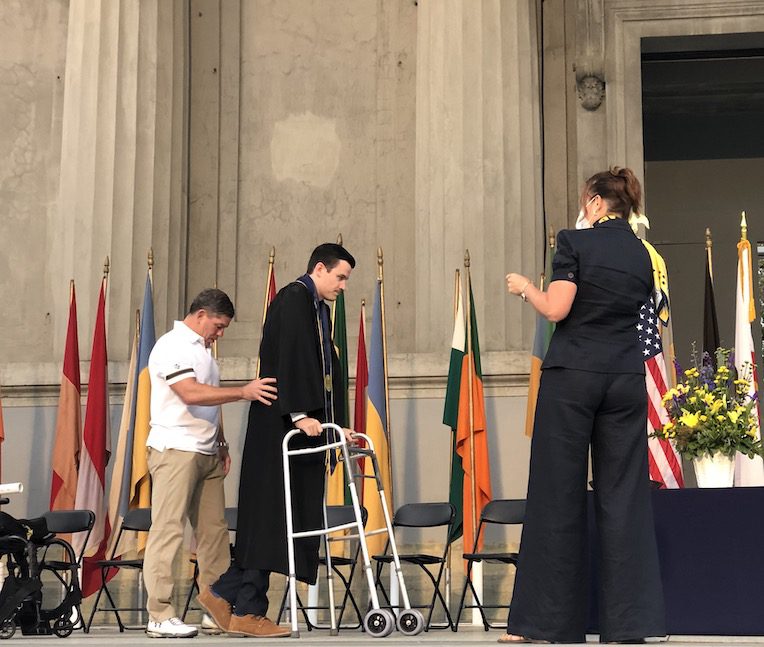
After the accident, Paylor underwent intense rehabilitation in Colorado before returning to UC Berkeley to finish his business degree, navigating the hilly Haas campus in his wheelchair.
He hit the gym with Billups for hours each day, measuring each week’s walking improvements in small increments. In October 2017, 16 months after the accident, fans cheered him on at California Memorial Stadium when he walked during the first quarter of the football game.
Paylor’s walking has dramatically improved since that game, Billups said.
“If you go all back to the catastrophic injury, he had no movement from the neck down—hands, fingers, nothing. That was pretty bleak,” he said. “When he walked at the Cal/Oregon game, he used a high walker, but the walker supports his forearms. Now he uses a low profile walker… He’s able to take more steps, more clean steps.”
At Haas, Paylor launched a business as an inspirational speaker, although the pandemic quickly pushed his engagements online, where he speaks to employees of Fortune 500 companies. He’s also started writing a book, which is part memoir, part motivational advice, tentatively titled “Paralyzed and Powerful.”
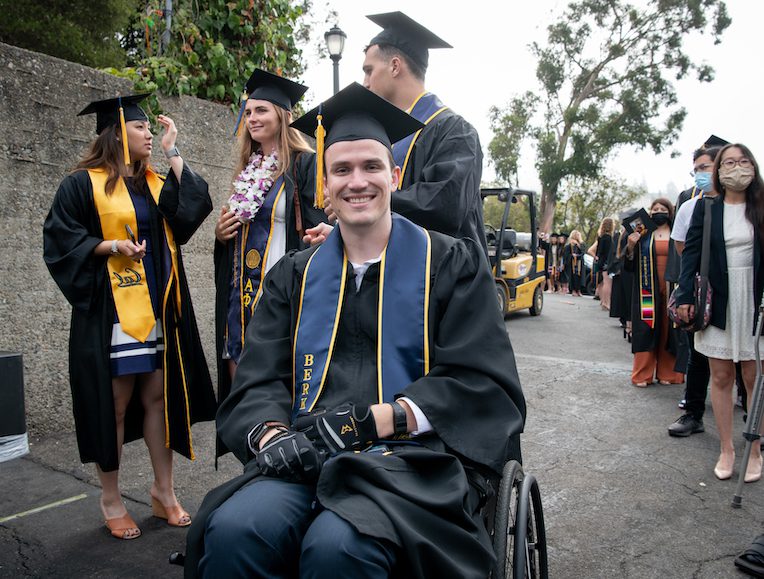
“The message is that you look at me and see my challenges, it’s not difficult to see that I have a lot to deal with every day, but everyone has challenges,” he said. “I believe that many people are paralyzed physically or mentally and the tools I use to overcome my challenges can help people in their lives.”
“I believe that many people are paralyzed physically or mentally and the tools I use to overcome my challenges can help people in their lives.”
For the past year, Paylor has been executive director of The Big C Society, an organization representing 14,000 Cal varsity athletics letter holders. Paylor said he’s honored to be part of the history and tradition of The Big C Society, which was founded in 1908.
“Coach Clark and Coach Billups came to the hospital after my injury and gave me that Cal letter,” he said. “The meaning of the letter is something I really care about so I immediately said yes.”
For achieving what some believed wasn’t possible, Paylor’s undergraduate community chose him to receive the Question the Status Quo award, one of the school’s four Defining Leadership Principles.
“While many may have treated that prognosis as an insurmountable challenge, Robert chose the path of perseverance, as he can now walk using his walker and graduated from the Haas School of Business,” said Steve Etter, who teaches finance at Haas and mentors student athletes. “His story has inspired thousands and serves as a living example that our limits are not determined by what others say we can do.”
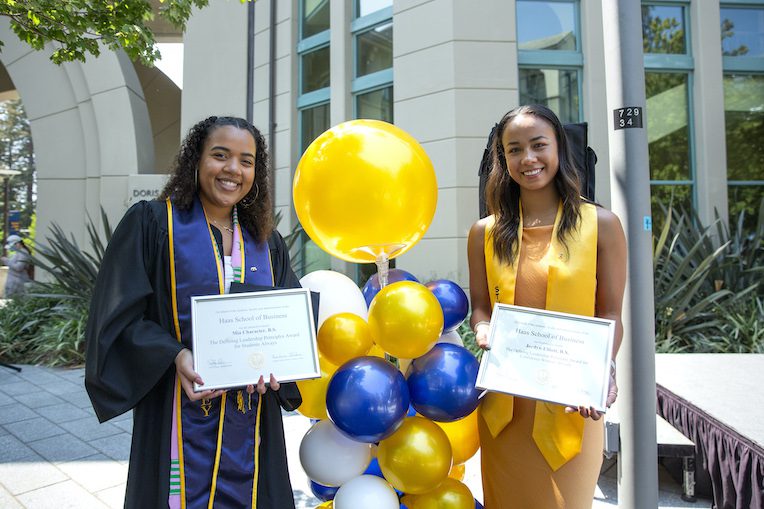
Award winners named
At a separate Haas undergraduate reception held in the school’s Courtyard at noon Sunday, Dean Ann Harrison congratulated the graduates and introduced Etter, who served as master of ceremonies, celebrating each 2020 award winner, including:
Departmental Citation winner (which goes to the student with the most outstanding academic achievement in the field of business): Cubbie Christina Kile, who graduated with a 4.0 while serving as a coxswain for the Women’s Rowing team. She was also a student athlete tutor, managed the Men’s Swimming team and was a member of Sigma Kappa Sorority. An analyst at Altamont Capital Partners, she recently closed her first deal, Intermix, a carve out from Gap, Inc.
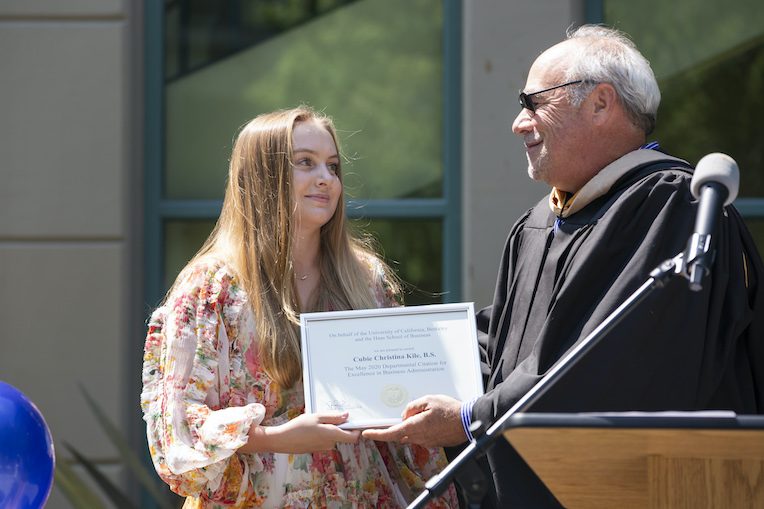
The Defining Leadership Principles awards followed, including (in addition to Paylor):
Students Always: Mia Character, whose nominator wrote: “Mia constantly strived to learn from others around race and ethnicity, and challenged herself to re-investigate her own beliefs as a marginalized person of color, striving to dig deeper on intent, while NOT tamping down the impact on her. She shared her vulnerabilities and self-challenges out loud in class, thereby inspiring others to do the same.”
Beyond Yourself: Kiara Taylor, whose nominator wrote: “Kiara made it her mission to make students attending California community colleges feel confident about transferring to Haas. Through the “Envision Haas” transfer outreach program, Taylor invited Haas transfer students with non-traditional backgrounds to speak to prospective transfer students, empowering both parties.”
Confidence Without Attitude: Jordyn Elliott. “Without asking, no one would know that Jordyn was a Soccer Team Captain at UC Berkeley and a graduating senior from the Haas School,” her nominator wrote. “After watching her lead the case team for the National Diversity Case Competition in Indiana, it was clear she understood the principle of Confidence without Attitude.”
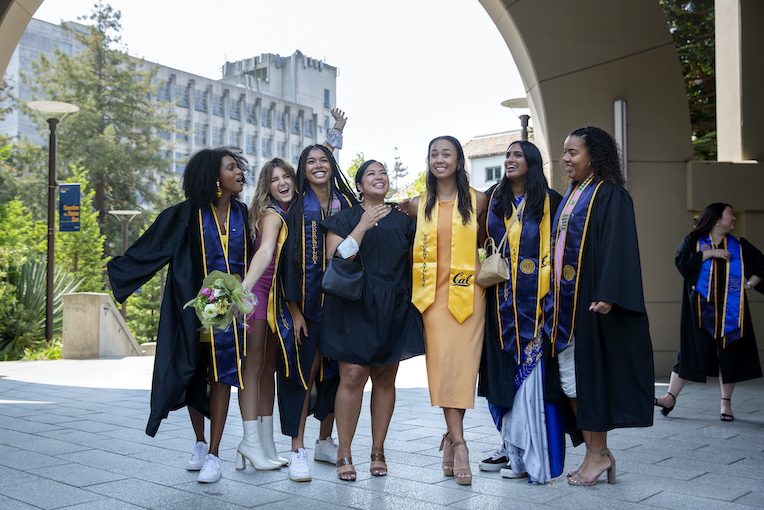
Berkeley News editor Gretchen Kell contributed to this story.
New undergrad, MBA, and PhD students arrive to start classes
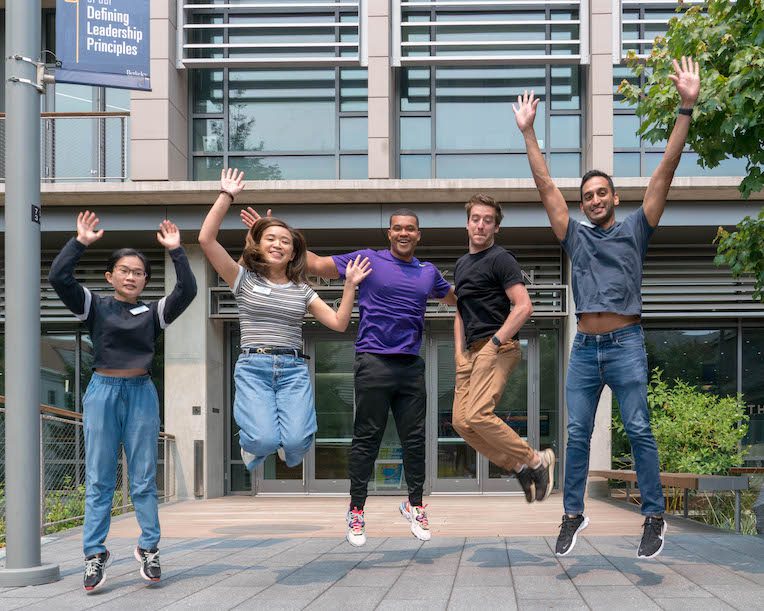
Berkeley Haas welcomed more than 750 new students to campus over the past week, kicking off the start of fall semester with a flurry of online and in-person events.
The new students, among the first to return to class in person since the COVID-19 pandemic, join the evening & weekend and executive MBA students who arrived earlier this summer.
Full-time MBA Program
A total of 291 new full-time MBA students in the Class of 2023 arrived for Week Zero, which is five days of sessions on topics including academic life at Haas. diversity, equity, and inclusion, and career planning. Second-year MBA students Vaibhav Anand, Jose Philip and Jessica Hwang served as Week Zero co-chairs.
Dean Ann Harrison welcomed the class at Andersen Auditorium during Monday’s kickoff. “Getting here is not easy,” said Harrison, who earned a bachelor’s degree from UC Berkeley with a double major in economics and history and served as a professor in the Department of Agricultural and Resource Economics from 2001 to 2011. “You’ve selected the right school and you really belong here.”
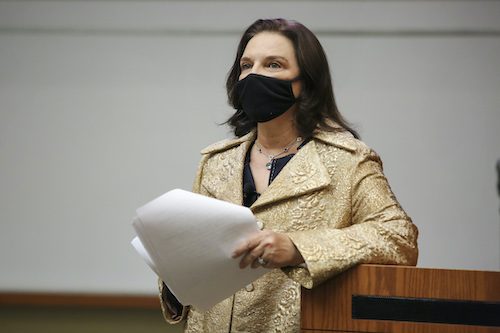
Harrison said the MBA program would challenge students both academically and personally. “We know that every single one of you has what it takes to succeed in this program,” she said, noting that the smaller program gives students the opportunity to get to know each other well.
Peter Johnson, assistant dean of the full-time MBA program and admissions, discussed the meaning of resilience, quoting Huffington Post founder Ariana Huffington, who described resilience as the ability to not only bounce back, but bounce forward.
“The fact that you are sitting here today shows that you have the capacity to bounce forward, and it’s a critical skill that’s going to enable you to be strong leaders now and in the future,” he said.
Throughout the week, students met with cohort members, joined “ask me anything” sessions with professors, took a sunset cruise, and performed community service at the supportive housing community Alameda Point Collaborative and its social enterprise, Ploughshares Nursery.
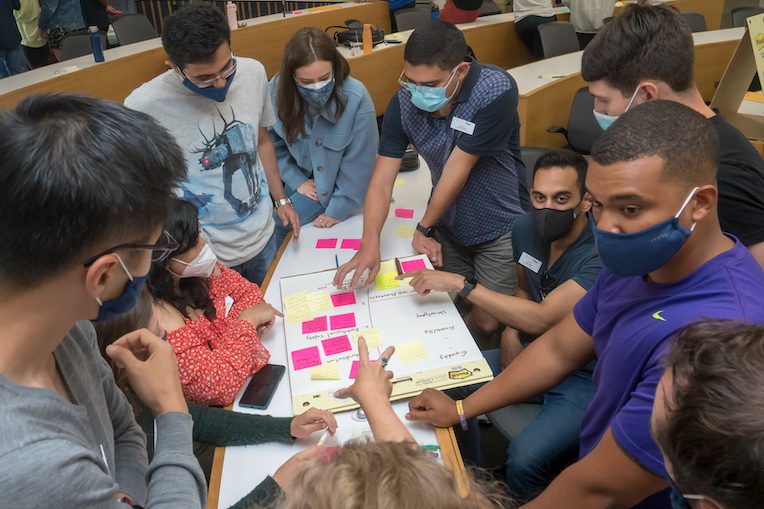
During orientation breaks, they gathered in the courtyard.
“It’s so nice to see everyone here,” said Anhelo Benavides, MBA 23, who grew up in Mexico and worked as a management consultant at Kearney in Dubai before coming to Haas. Highlights of orientation for her included meeting her cohort and hearing from Bree Jenkins, MBA 19, a leadership development associate at Pixar, who spoke to students about making their “house” at Haas into a true home.
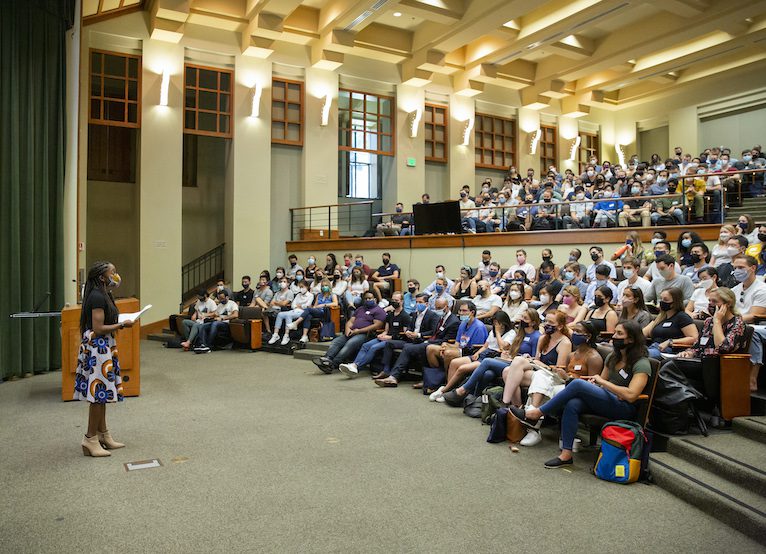
Benavides added that she loved the heartwarming welcome video from Haas alumni around the world, who greeted the students with a “Welcome to Haas” cheer. “This video brought joyful tears to my eyes,” she wrote on her Linkedin page.
A diverse group
The new MBA class is a diverse group composed of 38% women and 37% international students. About half the class are U.S. minorities, with 23% of the students identifying as underrepresented minorities (Black, Latinx, and Native American). Sixteen percent of the students are first in their families to attend college, and 14% of the class identifies at LGBTQ+.
The class is academically exceptional, with average GMAT scores of 726 and average GPAs of 3.67.

With an average of 5.4 years of work experience—about 19% of the students are from the consulting industry; 16% are from banking/financial services; 12% are from high tech; 7% are from nonprofits; and 7% are from healthcare/pharma/biotech.
Tomoe Wang, who joins the MBA program from Australia, said she’s planning a career pivot at Haas, so she found the Career Management Group’s orientation panel useful. Organized by MBA Career & Leadership Coach Julia Rosoff, the panel was led by second-year MBA students Caroline Shu, Shane Wilkinson, Lisa Chen, Rachel Stinebaugh, and Kayla Razavi.
“I had no idea what to expect with the hiring process, so it was good to have panelists walk you through it,” Wang said.

Thirty-nine students are enrolled in dual degree programs in public health, engineering, and law, including 19 MBA/MPH students, 18 MBA/MEng students, and two MBA/JD students.
John Thompson, MBA/MEng 23, of Shrewsbury, Mass, said he’ll be taking his first engineering courses at UC Berkeley, alongside his business courses. Thompson said he’s looking forward to joining the Food@Haas club, and is interested in exploring the intersection of agriculture and technology as a dual MBA/engineering major. “It’s an area ripe for innovation and growth,” he said.
Undergraduates
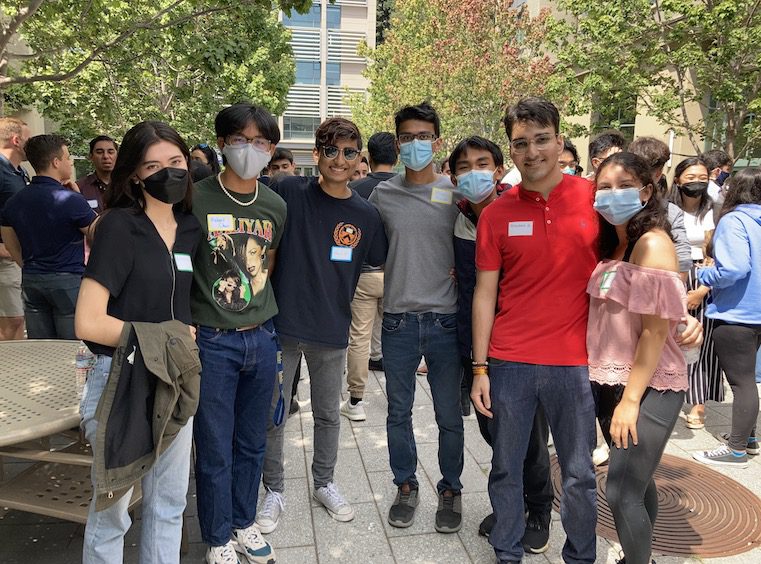
Dean Ann Harrison and Erika Walker, assistant dean of the Undergraduate Program, gave a warm welcome yesterday on Zoom to the 457 new undergraduate students. The group includes 245 continuing UC Berkeley juniors and 101 transfer students.
Continuing students hold an average GPA of 3.79, and the transfer students’ GPA averages 3.91. The class was accepted from a total of 3,304 applicants.
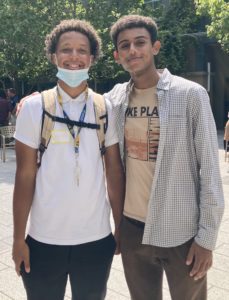
Joining orientation were 31 students in the undergraduate Global Management Program (GMP), a selective, four-year international Berkeley Haas program that launched in 2018, along with 25 students in the Robinson Life Science, Business, and Entrepreneurship program. The Management, Entrepreneurship, & Technology (M.E.T.) program, a collaboration between the Haas School of Business and the UC Berkeley College of Engineering, admitted 55 freshmen.
Orientation sessions on Zoom included a lecture by Distinguished Teaching Fellow Janet Brady, who discussed tools students need to be successful academically; an intro to career resources by Karen Lin, assistant director of career counseling; and an overview of the fall schedule.
Cohort events were held today in the Haas courtyard, including a team-building activity and a networking mixer.
PhD Program
The 2021 PhD cohort includes 12 students—seven women and five men. This year’s class includes two students in Accounting; three in Business and Public Policy; two in Finance; three in Marketing—one in Marketing Science and two in Behavioral Marketing; one in Management of Organizations (micro) and one in Management of Organizations student (macro).
The new students are from the U.S., India, France, China, South Korea, Taiwan, and Canada.
The Berkeley Haas PhD program is a five-year, full-time, in-residence program, leading to a PhD in Business Administration. There are a total of 69 students in the program.
Erika Walker named senior assistant dean of instruction
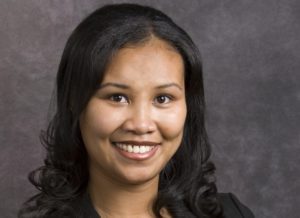
Erika Walker, who directed the Berkeley Haas undergraduate program for the past 16 years, has been named the school’s new senior assistant dean of instruction.
Walker, a UC Berkeley alumna, began her new role July 1. She succeeds Jay Stowsky, who held the position for 13 years.
“Erika has demonstrated outstanding leadership as assistant dean of our top-ranked undergraduate program,” said Dean Ann Harrison. “She is a leader in diversity, equity, and inclusion, student affairs, and leadership development. I am pleased that she is both the first woman and the first woman of color to serve in this position.”
In her new role, Walker will be a key member of the dean’s senior management team, responsible for leading instructional programs in the school’s six degree programs. She’ll oversee admissions, curricular innovation and planning, professional faculty hiring, academic advising, student services, and faculty teaching evaluations.
“Erika has demonstrated outstanding leadership as assistant dean of our top-ranked undergraduate program,” — Dean Ann Harrison.
“I am honored and excited to continue my journey at Haas in this new position, drawing on my undergraduate program experience to help lead the school during these transformative times,” Walker said.
Three new undergrad programs launched
As head of the two-year undergraduate program, Walker was in charge of all academic and student affairs. Most recently, she oversaw the addition of three innovative new undergraduate business programs: the Management, Entrepreneurship, & Technology (M.E.T.) program, a partnership with the UC Berkeley College of Engineering; the Robinson Life Science, Business, and Entrepreneurship (L.S.B.E.) program with Biological Sciences; and the Global Management Program, (G.M.P.), which features a semester abroad.
Deeply committed to diversity at Haas, Walker developed and taught the undergraduate course Diversity in the Workplace, which provides a forum for students to explore equity and inclusion issues. She also served as the first Haas Student Equity Officer, responsible for co-leading the school’s diversity and inclusion strategy. She also coached traveling international case competition teams each semester. Walker will continue to guide the undergraduate programs until the school names her successor.
A first-gen Cal grad
Prior to Haas, Walker was a manager at INROADS/Northern California, served as a program administrator for the Summer Youth Development Program at the McKesson Corporation, and as a project coordinator in Community and Government Relations at the regional offices of Kaiser Permanente.
Walker earned a BS in American Studies, with an emphasis in Health & Education for Minority Youth, from UC Berkeley. A first-gen college student, she was an inaugural recipient of UC Berkeley’s Incentive Awards Program, now called the Fiat Lux Scholars. She also holds an MA and EdD in Educational Leadership from Mills College. Her research area is intercultural pedagogy in higher education.
Haas refreshes core MBA curriculum, adds three new courses
Berkeley Haas is rolling out core curriculum changes designed to prepare MBA students for a fast-changing workplace by equipping them with enhanced communication skills and deeper data knowledge.
The refreshed curriculum includes additional training in business communications and persuasion skills, doubles the coursework in statistics and data analytics, and adds a brand new course—perhaps the first required core business class in the U.S., on leading diverse teams. The new courses will be rolled out in the full-time MBA program during the 2021-22 academic year.
An eight-member faculty task force worked throughout the pandemic to rethink the MBA core experience. The faculty in April unanimously approved the task force’s recommendations.

“I am so proud of the hard work that our faculty-led team put into these transformative core curriculum changes,” said Dean Ann Harrison, who created the core committee, which was led by co-chairs Prof. Ross Levine and Assoc. Prof. Dana R. Carney. “We are rolling out innovative courses that will help prepare our students for what’s next, addressing a wide range of workplace challenges—from questioning the ethics of artificial intelligence to recognizing how unconscious bias impacts management decisions.”
Three new courses
The MBA core consists of 14 required courses that form the fundamental building blocks of a general management education. The classes are designed to build on each other, providing students with the analytical tools and knowledge required to manage complex managerial problems–skills every employer expects from an MBA.
The MBA core consists of 14 required courses that form the fundamental building blocks of a general management education.
The three courses added to the core include:
- Data Analytics will provide more extensive training in data analytics, artificial intelligence, and related approaches to using big data for decision making. The course is a companion to the existing Data and Decisions statistical analysis course.
- Data-Driven Presentations: Making the Business Case will better prepare students to make persuasive arguments using data and narrative. It builds on the knowledge and experience developed in the courses Data and Decisions and Leadership Communication.
- Business Communication in Diverse Work Environments will help students navigate diverse settings more effectively to improve their ability to create, work within, and lead diverse teams and global organizations. It also develops critical thinking on topics such as identity, relationships across differences, bias, and equality of opportunity in organizations.
Levine said he was proud of the group’s camaraderie and collaboration and the transparency of the process.
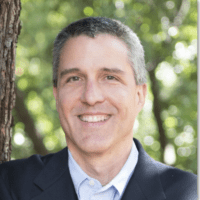
“It’s very important for any type of program to re-evaluate, reassess, renew, modernize, and make things as relevant and useful for students as possible,” said Levine, the Willis H. Booth Chair in Banking and Finance. “We worked very hard to make some changes that would help our students achieve their professional ambitions.”
Jay Stowsky, who served as Senior Assistant Dean of Instruction for the past 13 years, added that the curriculum changes will make it easier for faculty “to address, with relevance to each of their courses and academic disciplines, the broader social impacts of business.”
Evidence-based changes
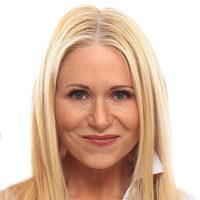
Copious research enabled the task force to have full confidence in the proposed core changes, said Carney, a psychologist who studies racial bias and is the director of the Institute of Personality and Social Research at UC Berkeley. “We knew that we had to have a lot of data to guide and substantiate the changes the data suggested we make; we made sure the data we collected were unimpeachable,” she said.
As part of this research, the task force members sought extensive feedback from different groups before making its recommendations. They met with tenure-track and teaching faculty and current students and separately with MBA students active in the Race Inclusion Initiative (RII) and the Gender Equity Initiative (GEI) at Haas.
“We knew that we had to have a lot of data to guide and substantiate the changes the data suggested we make.” – Assoc. Prof. Dana Carney.
The task force also worked closely with the Haas Board and the Career Management Group (CMG), which developed a survey of recent alumni and collected data from corporate recruiters on the skills they seek when hiring. Early in the process, two clear areas in the existing curriculum emerged that would need a fresh and upgraded experience—interacting with people and interacting with data, Carney said.
Jenn Bridge, senior director of employer engagement & industry readiness at Haas, said her team’s interviews with recruiters and alumni surveys aligned with findings in the World Economic Forum’s Future of Jobs report, confirming the demand for strong data and people-centered skills.
“Being nimble as a leader and managing people through change are skills that are highly desired,” she said. “The pandemic has accelerated all of this.”
Learn by doing
One of the ways the task force made room in students’ schedules for the new core courses was to to shift the decade-old Fundamentals of Design Thinking course from the core to an elective.
Haas pioneered teaching design thinking as part of an MBA core refresh in 2010. Since then, design thinking has become a standard approach to problem solving, woven throughout the curriculum, especially in the required project-based Applied Innovation electives. MBA students will continue to “learn by doing” through design thinking and other decision-making approaches, Stowsky said.
The part-time MBA programs are considering the core refresh in light of the needs of their students. In the Evening & Weekend MBA program, the Business Communications in Diverse Environments core course will be added to the core and become the capstone course, while the two new data-focused courses will offered as electives. Implementation in the MBA for Executives program is under discussion with the EMBA Academic Program Committee.
Haas Olympian event times
Haas Olympians competing in Tokyo include swimmers Ryan Murphy and Alicia Wilson, water polo player Johnny Hooper, and golfer Collin Morikawa. Here are their event times.
All times are start times. There may be several events on the same day in swimming.
| Ryan Murphy | Day in CA | Pacific Time | Day in Japan | Japan Time |
| 100-m back prelim | Sun., July 25 | 3:00 a.m. | Sun., July 25 | 7:00 p.m. |
| 100-m back semis | Sun., July 25 | 6:30 p.m. | Mon., July 26 | 10:30 a.m. |
| 100-m back final | Mon., July 26 | 6:30 p.m. | Tues., July 27 | 10:30 a.m. |
| 200-m back prelim | Wed., July 28 | 3:00 a.m. | Wed., July 28 | 7:00 p.m. |
| 200-m back semis | Wed., July 28 | 6:30 p.m. | Thurs., July 29 | 10:30 a.m. |
| 200-m back final | Thurs., July 29 | 6:30 p.m. | Fri., July 30 | 10:30 a.m. |
| Alicia Wilson | ||||
| 200-m IM prelim | Mon., July 26 | 3:00 a.m. | Mon., July 26 | 7:00 p.m. |
| 200-m IM semis | Mon., July 26 | 6:30 p.m. | Tues., July 27 | 10:30 a.m. |
| 200-m IM final | Tues., July 27 | 6:30 p.m. | Wed., July 28 | 10:30 a.m. |
| Johnny Hooper | ||||
| Prelim vs. Japan | Sat., July 24 | 10:00 p.m. | Sun., July 25 | 2:00 p.m. |
| Prelim vs. S. Africa | Mon., July 26 | 6:00 p.m. | Tues., July 27 | 10:00 a.m. |
| Prelim vs. Italy | Wed., July 28 | 10:00 p.m. | Thurs., July 29 | 2:00 p.m. |
| Prelim vs. Hungary | Fri., July 30 | 10:00 p.m. | Sat., July 31 | 2:00 p.m. |
| Prelim vs. Greece | Sun., Aug. 1 | 6:00 p.m. | Mon., Aug. 2 | 10:00 a.m. |
| Quarterfinals | Tues, Aug. 3
Wed., Aug. 4 |
10:00 p.m.
2:30 a.m. |
Wed., Aug. 4 | 2:00 p.m. 6:30 p.m. |
| Semifinals | Thurs., Aug. 5
Fri., Aug. 6 |
10:00 p.m.
2:30 a.m. |
Fri., Aug. 6 | 2:00 p.m. 6:30 p.m. |
| Bronze medal match Finals |
Sat., Aug. 7
Sun., Aug. 8 |
9:30 p.m.
12:30 a.m. |
Sun., Aug. 8 | 1:30 p.m.
4:30 p.m. |
| Collin Morikawa | ||||
| Round 1 | Wed., July 28
Thurs., July 29 |
3:30 p.m. –
Midnight |
Thurs., July 29 | 7:30 a.m.–4:00 p.m. |
| Round 2 | Thurs., July 29
Fri., July 30 |
3:30 p.m. –
Midnight |
Fri., July 30 | 7:30 a.m.–4:00 p.m. |
| Round 3 | Fri., July 30
Sat., July 31 |
3:30 p.m. –
Midnight |
Sat., July 31 | 7:30 a.m.–4:00 p.m. |
| Round 4/Finals | Sat., July 31
Sun., Aug. 1 |
3:30 p.m. –
12:30 a.m. |
Sun., Aug. 1 | 7:30 a.m.–4:30 p.m. |
Schedule of Events: https://olympics.com/tokyo-2020/en/schedule/
Time converter (JT to PT): http://www.timebie.com/timezone/tokyoportland.php
Q&A: Alicia Wilson, BS 22, on momentum that led to the Tokyo Olympics
Perhaps no one is more surprised that swimmer Alicia Wilson, BS 22, will be competing in the Olympics than Alicia Wilson herself. When the rising senior from England first joined the Cal swim team, she says she was nowhere near the fastest, placing herself toward the bottom of the pack. But a breakout freshman year followed by an even better sophomore year changed her perspective. “The Olympics have always been a dream of mine but never a goal,” she says. “And then my sophomore year the momentum kept going and I thought, ‘Wow, I could actually do this.’”

Alicia Wilson,Free/IM
She attributes her success largely to Coach Teri McKeever, who encourages unconventional training, like taking gymnastics or dance to work different muscles. The result for Wilson was a lifetime best in the 200-yard individual medley, a technically challenging race involving equal parts backstroke, butterfly, breaststroke, and freestyle, in the 2021 season—a record she then broke in her Olympic trials (for the 200-meter IM) to earn a spot on Great Britain’s team heading to Tokyo.
We caught up with Wilson while she was at a national training facility in England, days before she heads to Tokyo.
The individual medley is arguably the most challenging in swimming. What’s the secret to being good at it?
It takes a lot of versatility, because you’re obviously changing strokes and muscle groups—about every 30 seconds for the 200-meter. It’s like a sprint, and you can’t really afford to have a weak stroke. But it’s quite refreshing that I don’t have to do the same thing every day. I can mix up my strokes or if I’m having a bad day on one of them, I have the luxury to then try and improve somewhere else. Just being flexible is huge with the IM.
It’s like a sprint, and you can’t really afford to have a weak stroke
How do you prepare mentally?
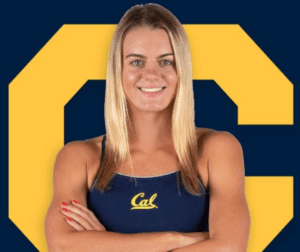
Staying focused on myself is something that I’m really working on. In the UK, I’m very aware of the people I race because I’ve raced them for 12 years and I know people’s strengths. I’m starting to get that same familiarity in the U.S. But at the Olympics, I’m generally not going to understand who’s good at what. As much as [IM swimmers] try to not have a weak stroke, you’re going to have one of the four that you don’t favor. There will be a length where I’ll be behind or ahead and that’s how it goes. In the end, it’s who touches the wall first.
Most people are lucky to be good at one or two things. How do you go about becoming skilled—and staying competitive—at four different strokes?
I tap into the ethos of [Coach] Teri McKeever. She’s all about innovating yourself to become a better swimmer and a better athlete and person. I embraced that more than ever this year and having an extra year because of COVID has allowed me to get better. Since coming to Cal, I’ve also had a lot of fun racing teammates who specialize in each stroke. Trying to keep up with them has helped me improve on each of my individual strokes so that when it comes together, it’s a lot stronger.
How do you keep mitigate stress as the Olympics get closer?
I’m really lucky that Teri is on the U.S. Olympic team as a coach. Knowing that I’ll have my Olympic debut with my coach there, even though she’s from another country, is going to be very special. That keeps me level-headed. And I try to do stuff that I enjoy when I’m not at the pool. It’s really important for me to unwind because it’s just so intense, those periods of training. I’m a dog person and love spending time with my dogs—two Bernese mountain dogs and a Labrador. Apparently you walk a lot in the Olympic village, so my mom and I have been taking a lot of dog walks.
What does it mean to you to represent your country in the Olympics?
My inspiration started in 2012 when the London Olympic games were literally on my front doorstep—the cyclers passed my house. I was definitely star-struck seeing all the different athletes and that fueled me to take swimming a little more seriously. I can’t quite believe that I get to be the person whom I looked up to when I was 12. And it means even more given the pandemic. Last year was probably the toughest of my life. So to have that dream and then the past year combined, it’s hard to put into words because it means so much.
My inspiration started in 2012 when the London Olympic games were literally on my front doorstep—the cyclers passed my house.
What life lessons have elite competitive swimming taught you?
I think the biggest one is the value of honesty and support. I struggled this year, and had I not had support at Cal and from the Haas faculty I would definitely have not gotten through to where I am now. I just wish I had voiced my need for help a lot sooner, because once you do it opens up so much more and everything’s a lot easier with a team behind you, obviously. Learning to communicate better has been a lifeline to me. I’m so lucky to have the community at Berkeley that has lifted me up and allowed me to get to where I am.
Qualifying heats for Wilson’s event, the 200-meter IM, will be Monday, July 26, starting at 7:00 p.m. Japan Time (3:00 a.m. PT on July 26). Semifinals for the event will be held Tuesday, July 27, starting at 10:30 a.m. JT (6:30 p.m. PT on July 26). The finals will be Wednesday, July 28, starting at 10:30 a.m. JT (6:30 p.m. PT on July 27).
Tokyo bound: Four Haasies to compete in summer Olympics
After a year of delays due to the COVID-19 pandemic, the summer Olympics are here—and four Haasies are in Tokyo to compete in golf, swimming, and water polo.
The Games of the XXXII Olympiad are scheduled from from July 23 to Aug. 8, 2021. The group of competing Haas athletes includes:
Collin Morikawa
Collin Morikawa, BS 19, joins Justin Thomas, Xander Schauffele and Bryson DeChambeau on the men’s U.S. golf team.

The U.S. will have have more golfers represented than any other nation during this year’s Games, according to Golf magazine. Pro-golfer Morikawa won the 2020 PGA Championship in his first-ever attempt last year.
When he enrolled at UC Berkeley, Morikawa had a single-minded focus to learn how he could succeed as a professional golfer, treating the endeavor as much as a job as a sport. “If you look at big professional athletes, they’re running their own business, which is their name and their brand,” he told Berkeley Haas Magazine. “I wanted to invest in my future and learn as much as I could so when I turned pro I would be ready for the outside world.”
Ryan Murphy

Ryan Murphy, BS 17, is competing in his second Olympics, qualifying again in the 100- and 200-meter backstroke.
In 2016, Murphy won gold in both the 200m and 100m backstroke, and swam to victory in the 400m relay medley with Olympic legend Michael Phelps, Cal alum Nathan Adrian, and Cody Miller. “I honestly didn’t think I’d win the 200m backstroke, but that’s the event I really trained for,” he told Berkeley Haas News at the time. “The 100m back comes a little more naturally to me, so the 200 is the one I have to really work for. It’s the one that meant a lot because I know what’s gone on behind that whole race and what I did in coming up with the best strategy to win it.” This year, he’s serving as an Olympic team captain for USA swimming.
Johnny Hooper
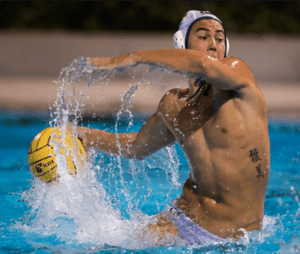
Johnny Hooper, BS 19, a 6’2″ attacker, qualified for Tokyo as a member of the Men’s Senior National Team, USA Water Polo. Hooper is Cal’s #2 all-time leading scorer with 245 goals, and he helped lead the squad to the 2016 NCAA Championship. The team trained remotely during the pandemic, and Hooper, along with many of his teammates, spent part of the last year playing professionally in Europe.
Alicia Wilson

Alicia Wilson, BS 22, qualified for a spot on Great Britain’s swim team to compete in the 200-meter individual medley, a technically challenging race involving equal parts backstroke, butterfly, breaststroke, and freestyle. Wilson, a rising senior from England, had an incredible 2021 season, capturing the 2021 Pac-12 crown in the 200-yard individual medley.
Wilson said her inspiration started in 2012 when the London Olympic games “were literally on my front doorstep.” Read an interview with Wilson here.